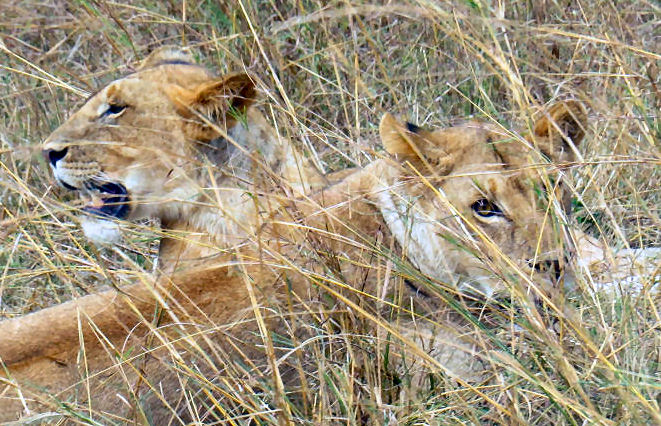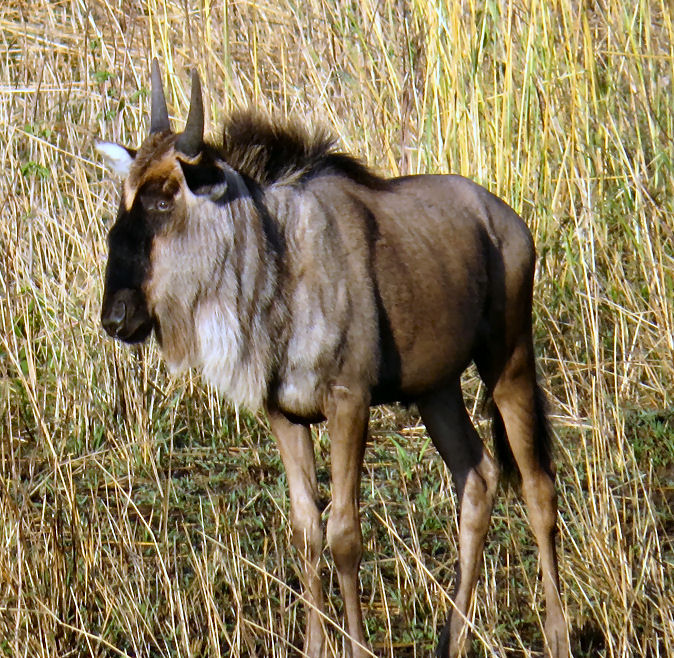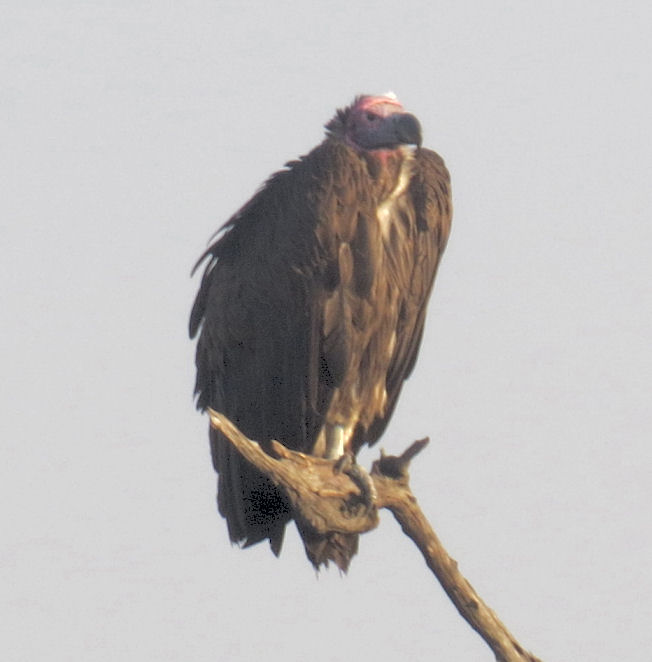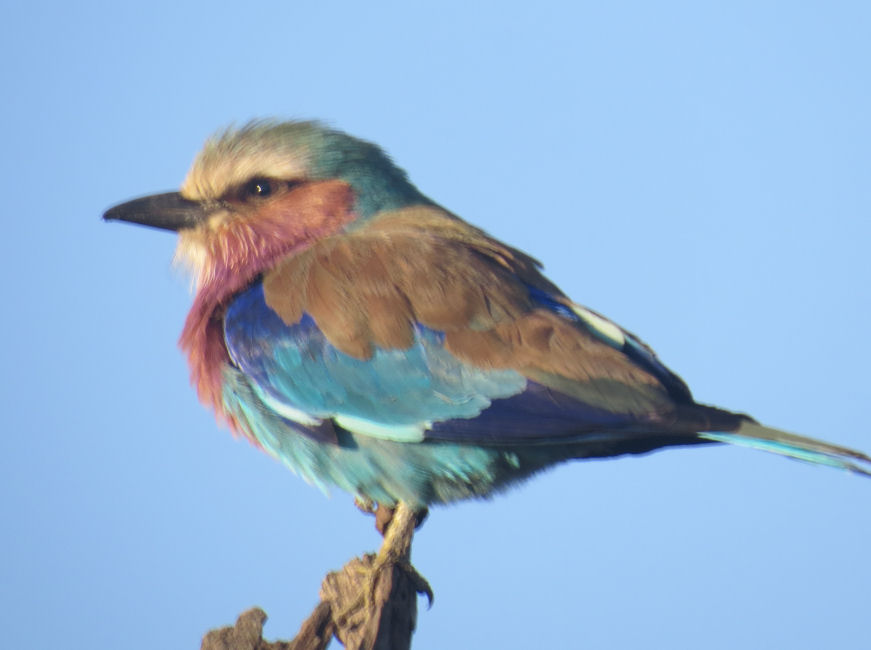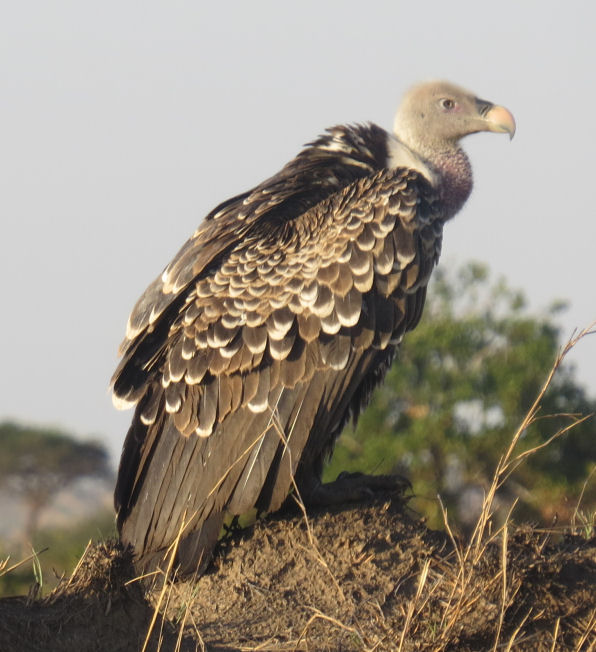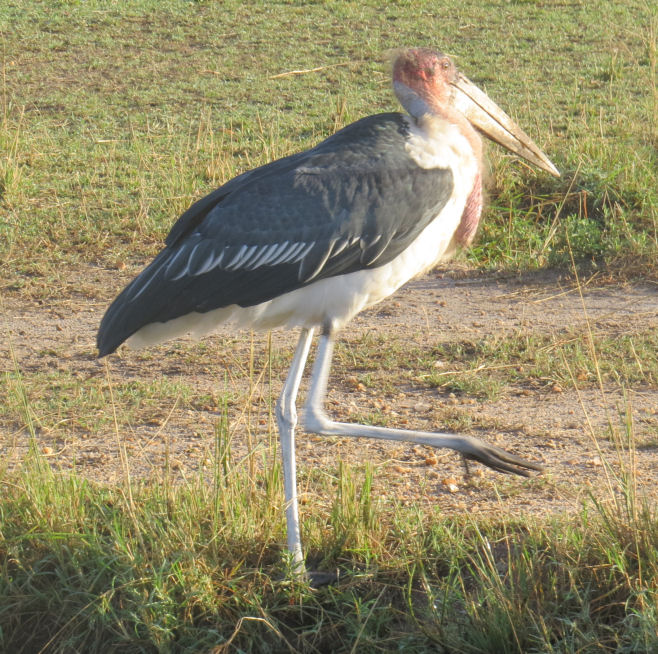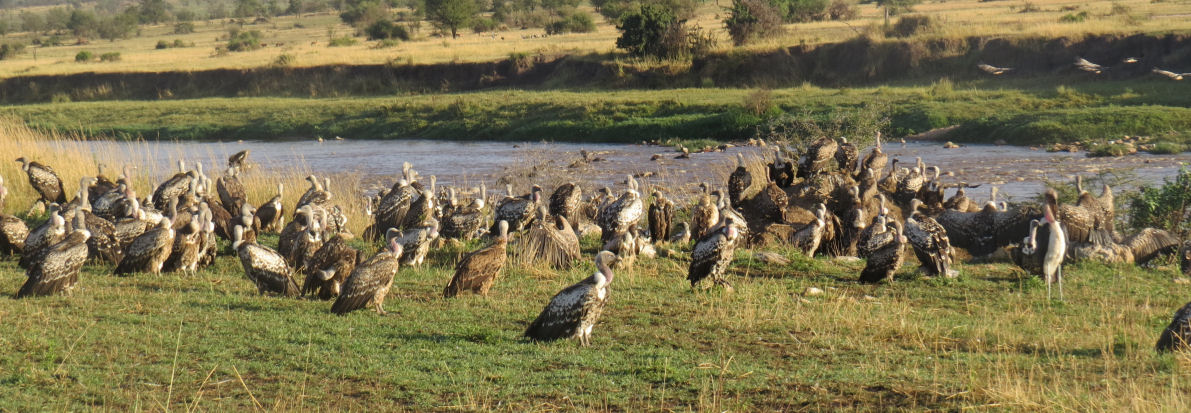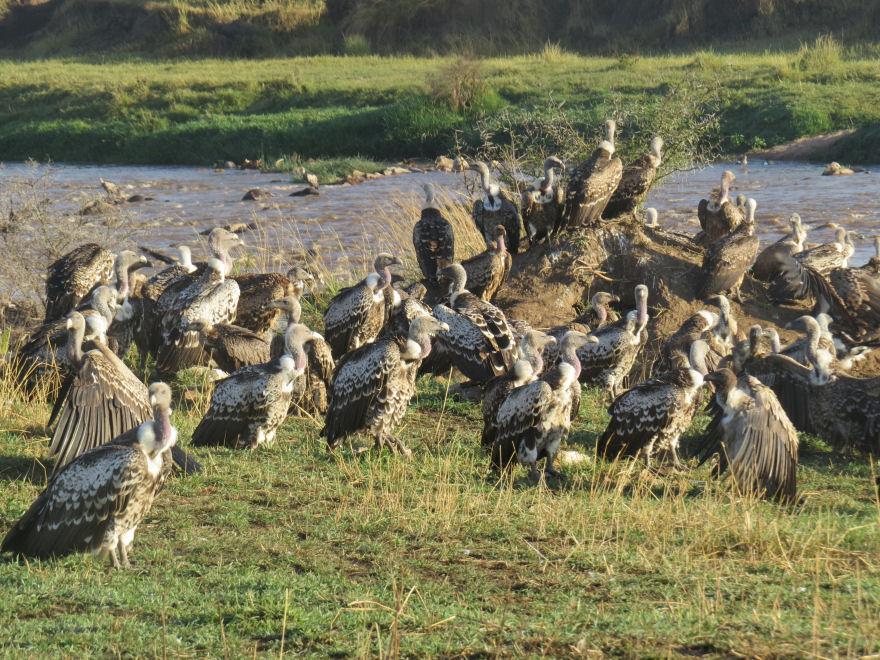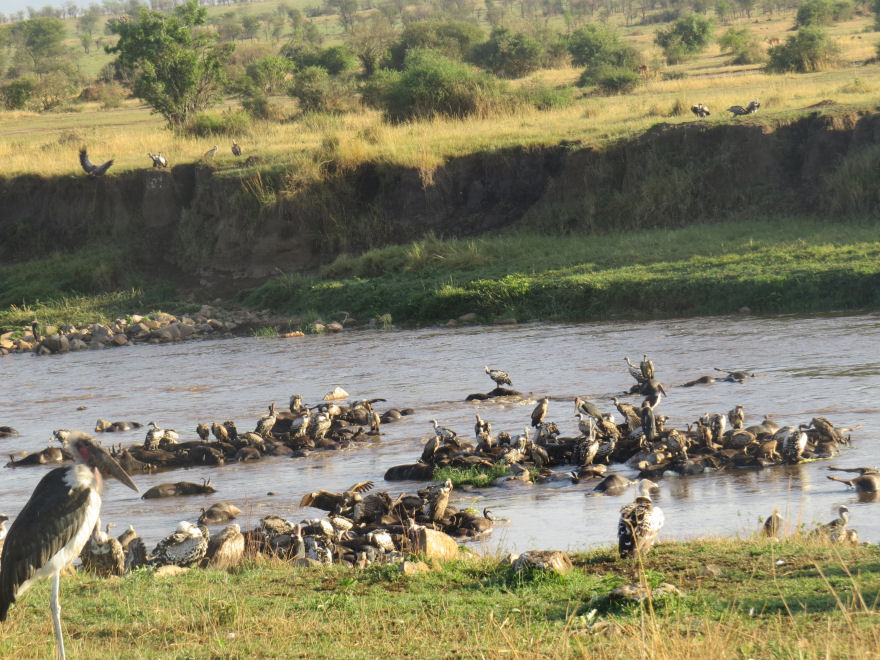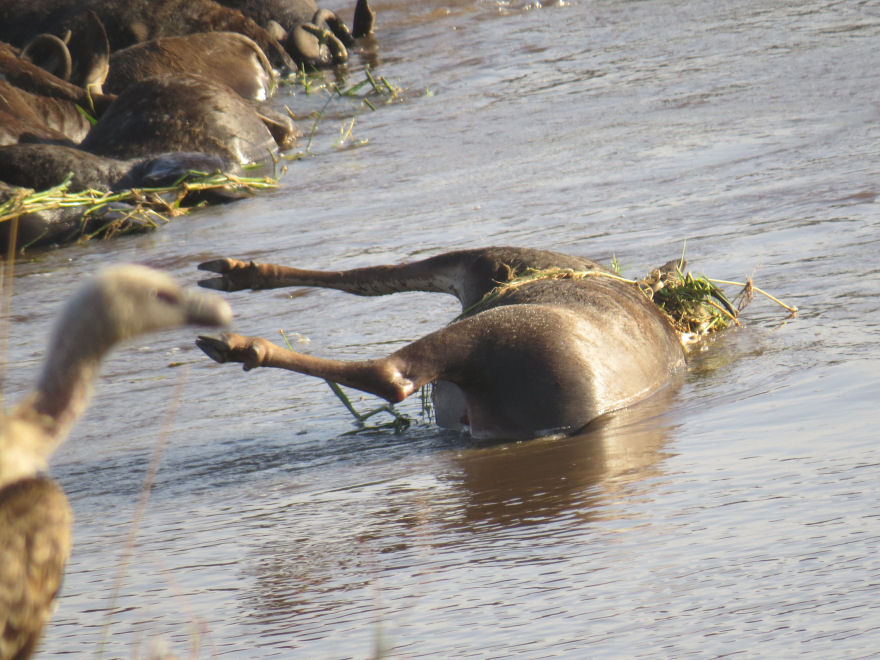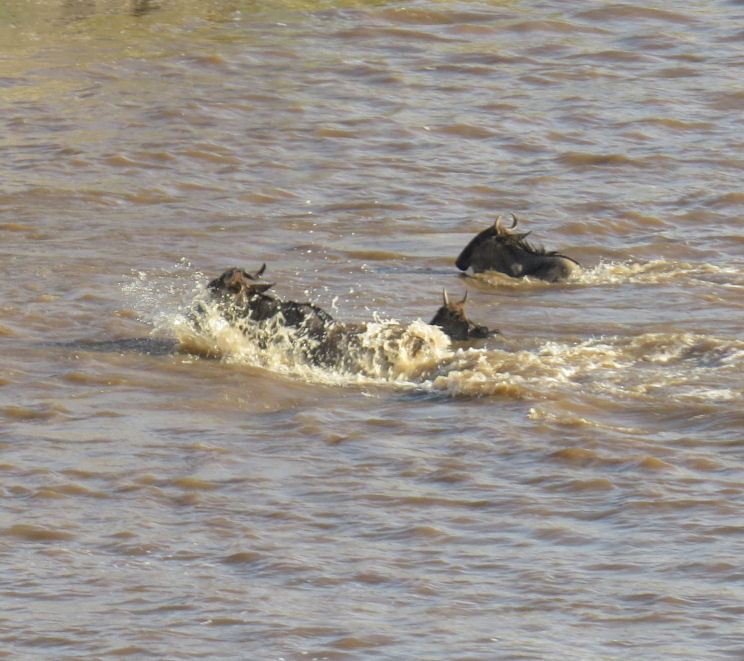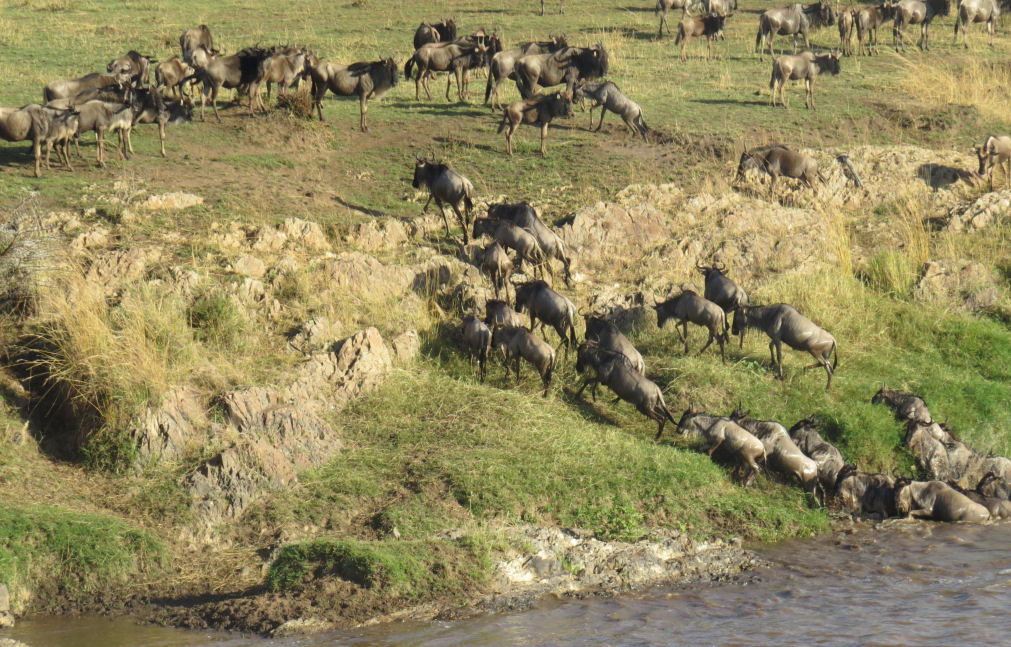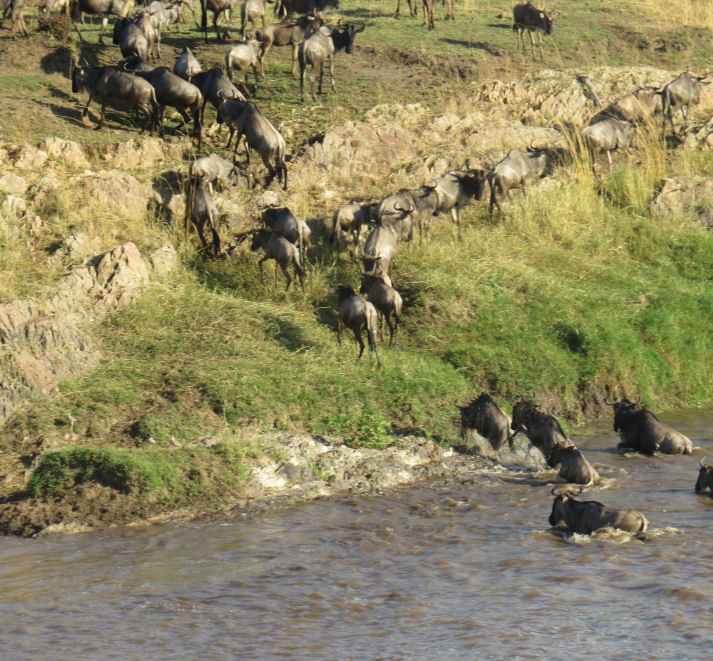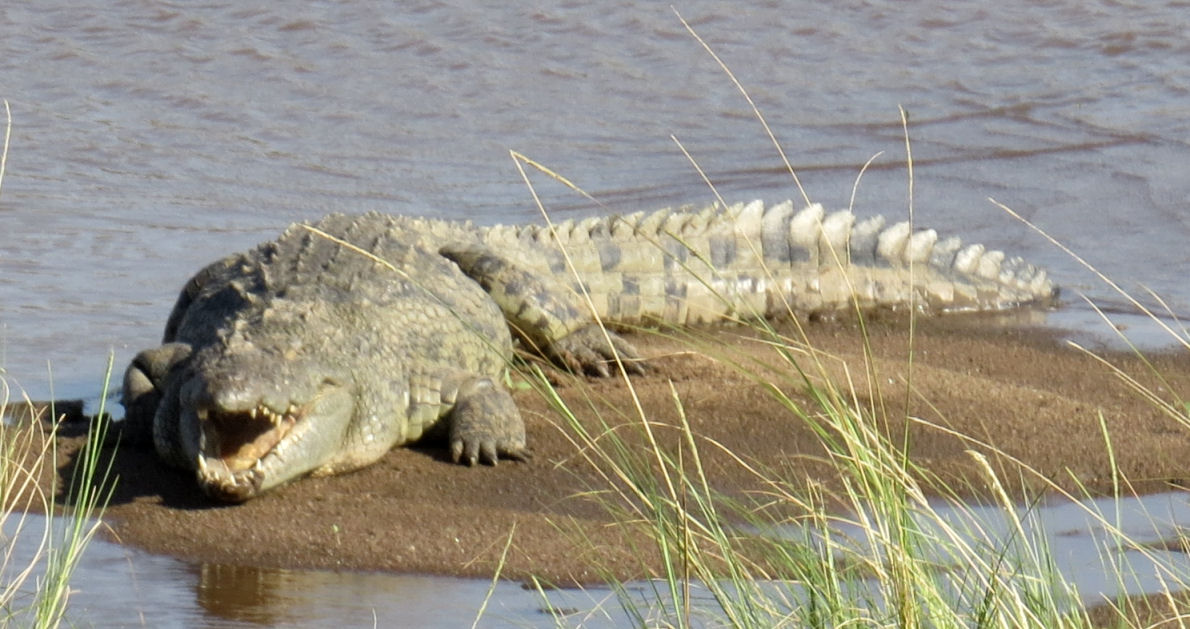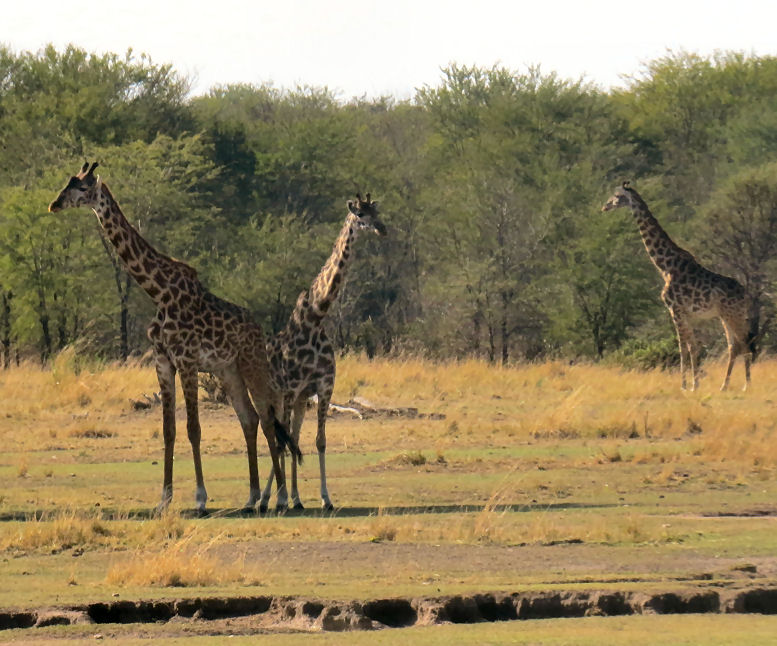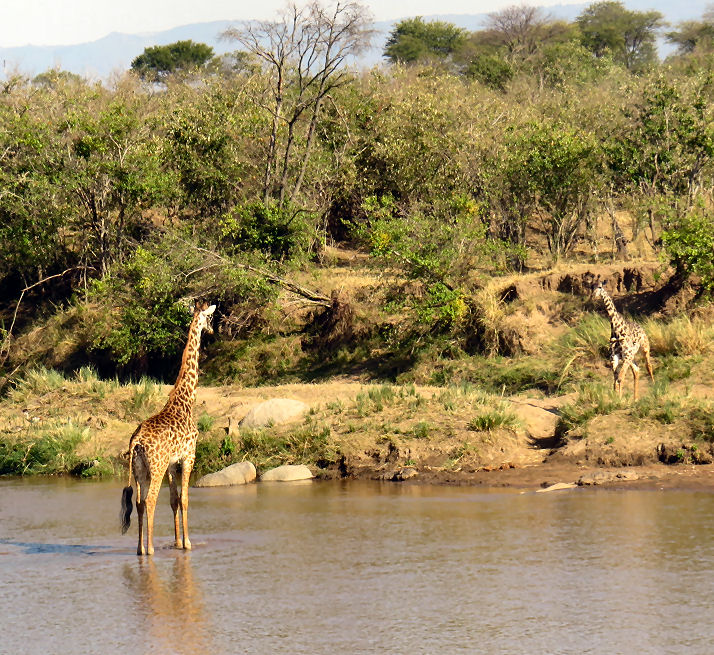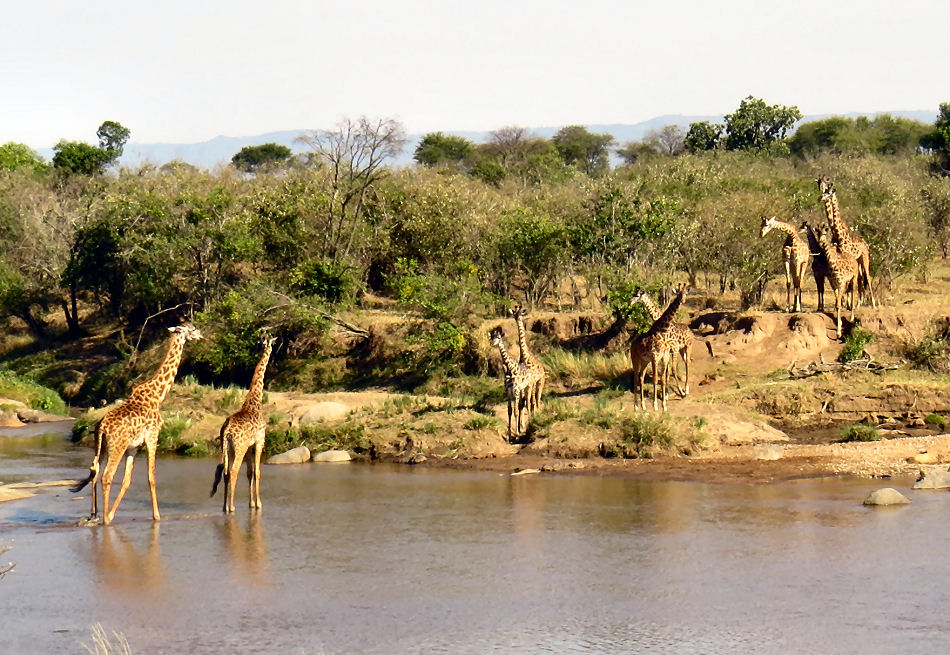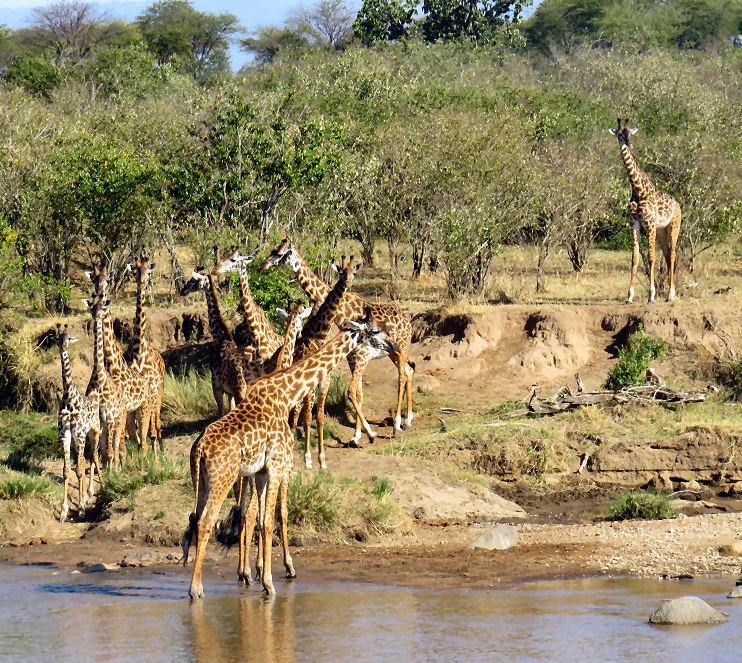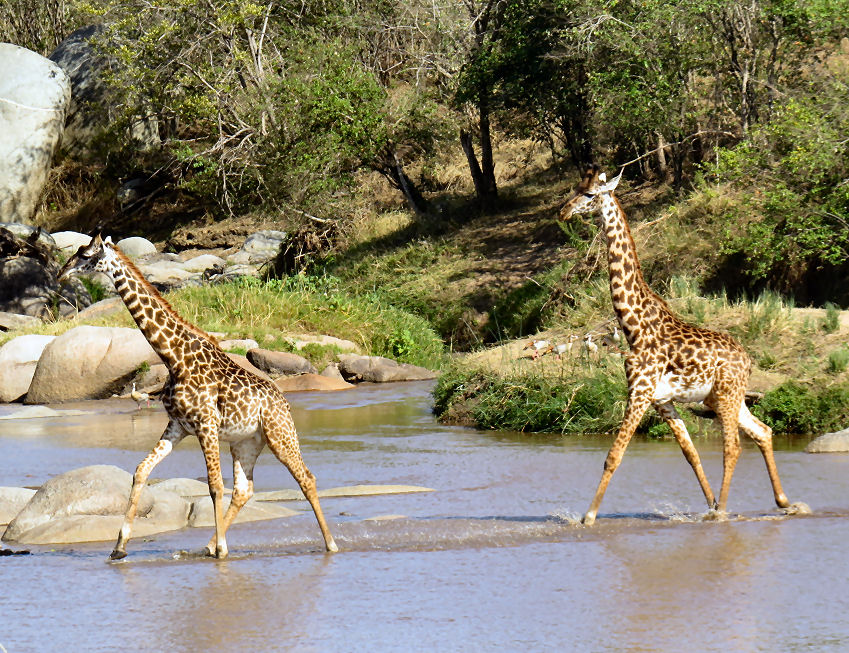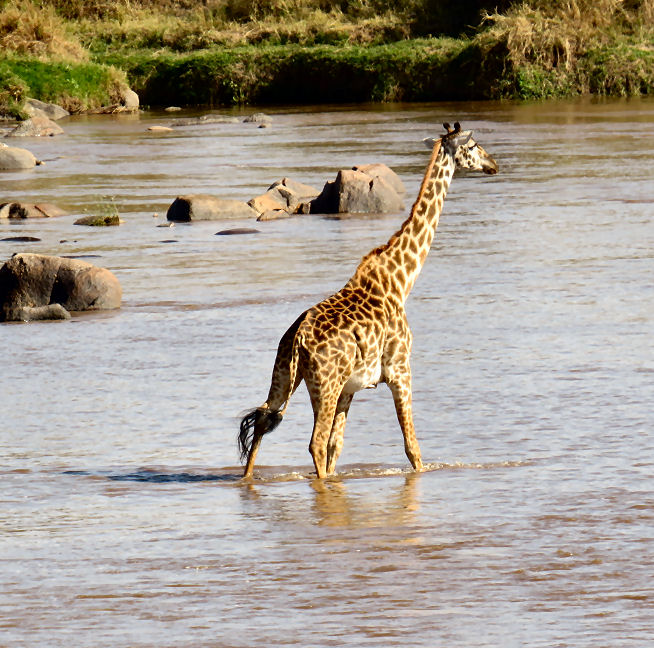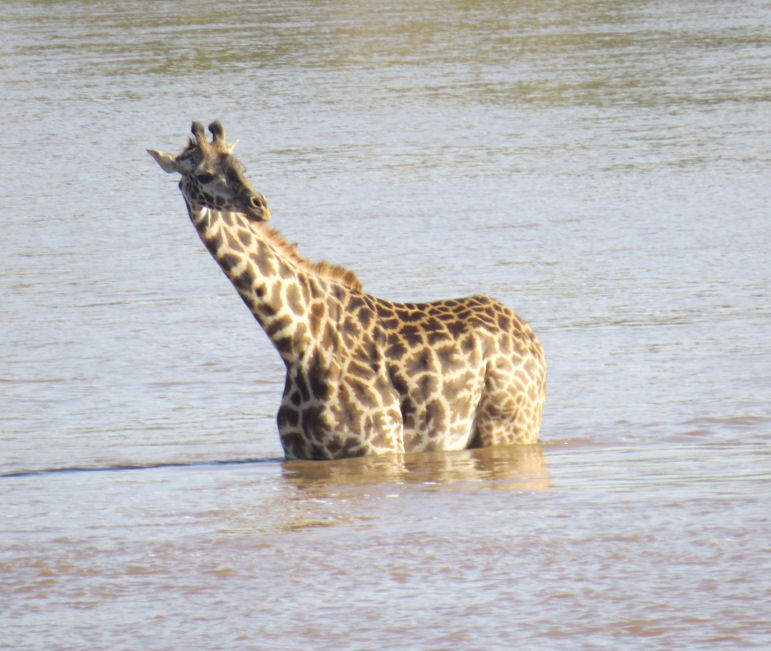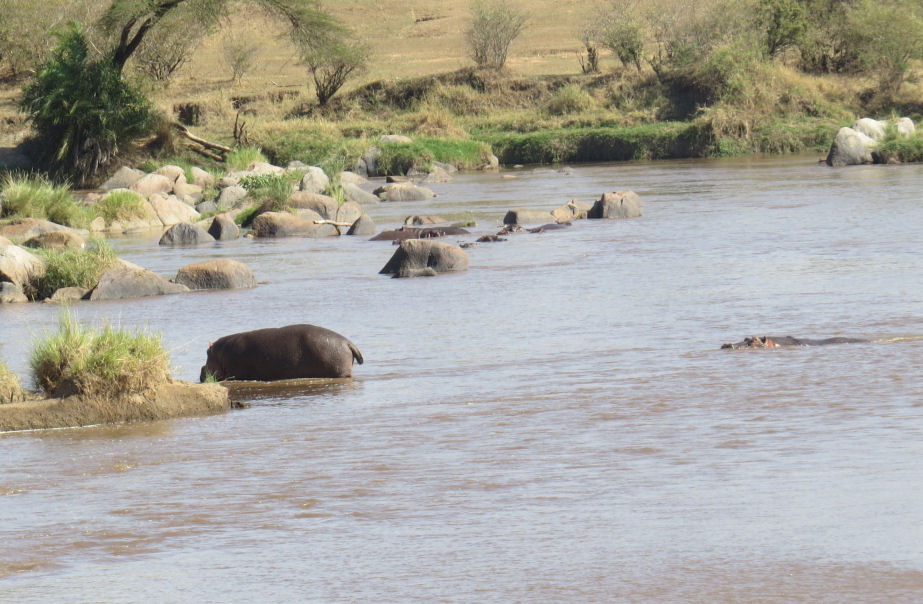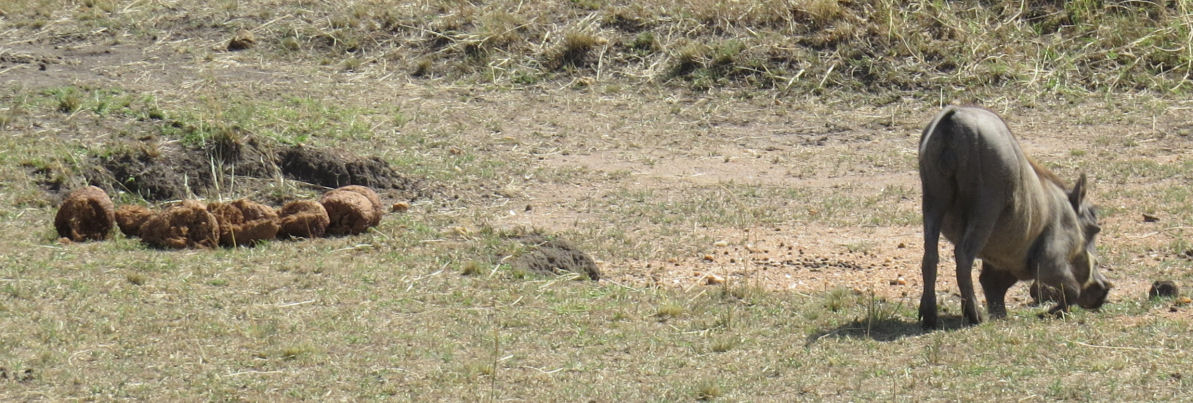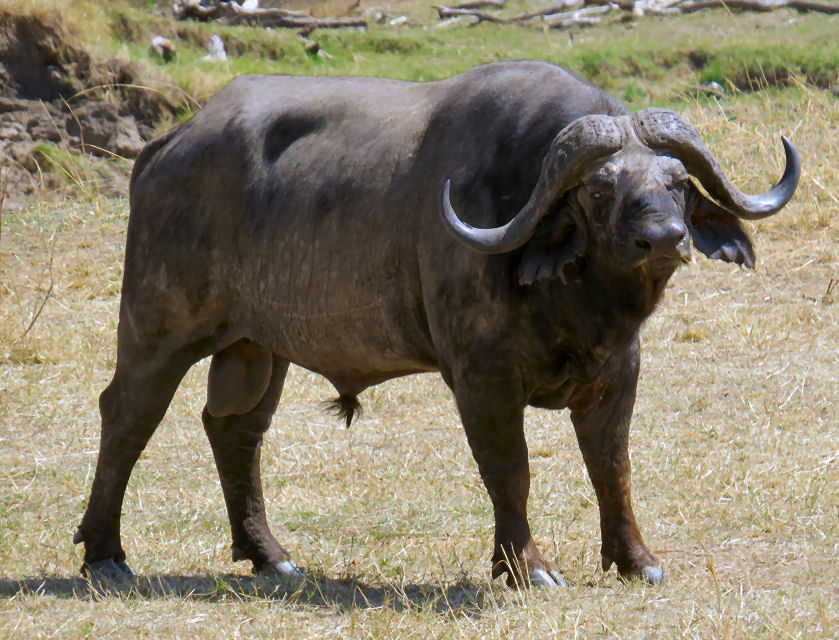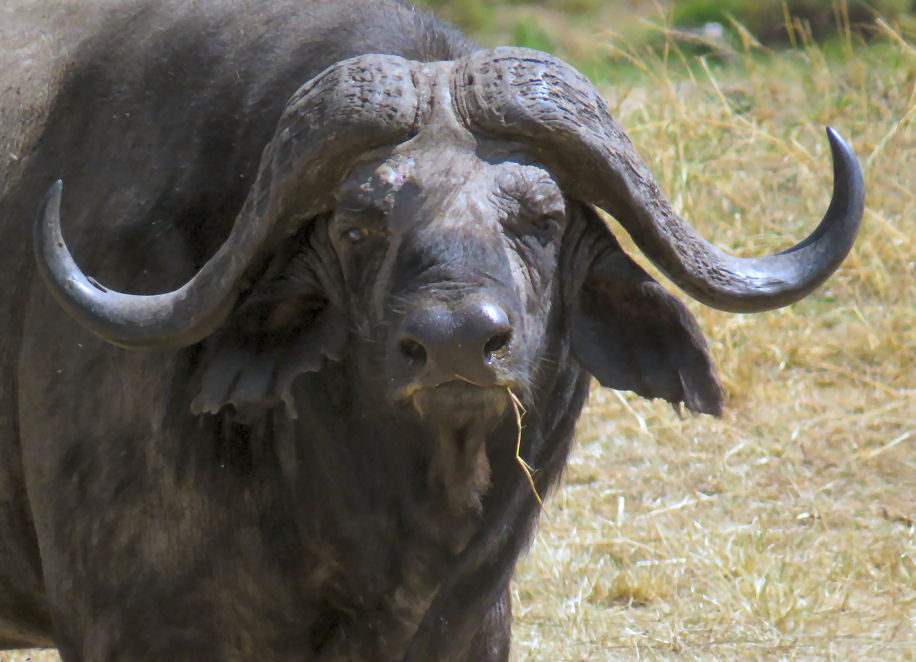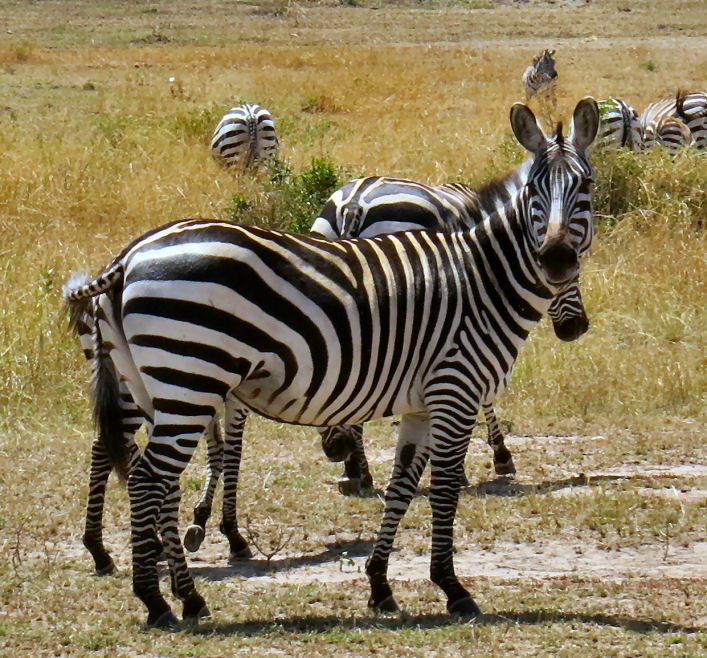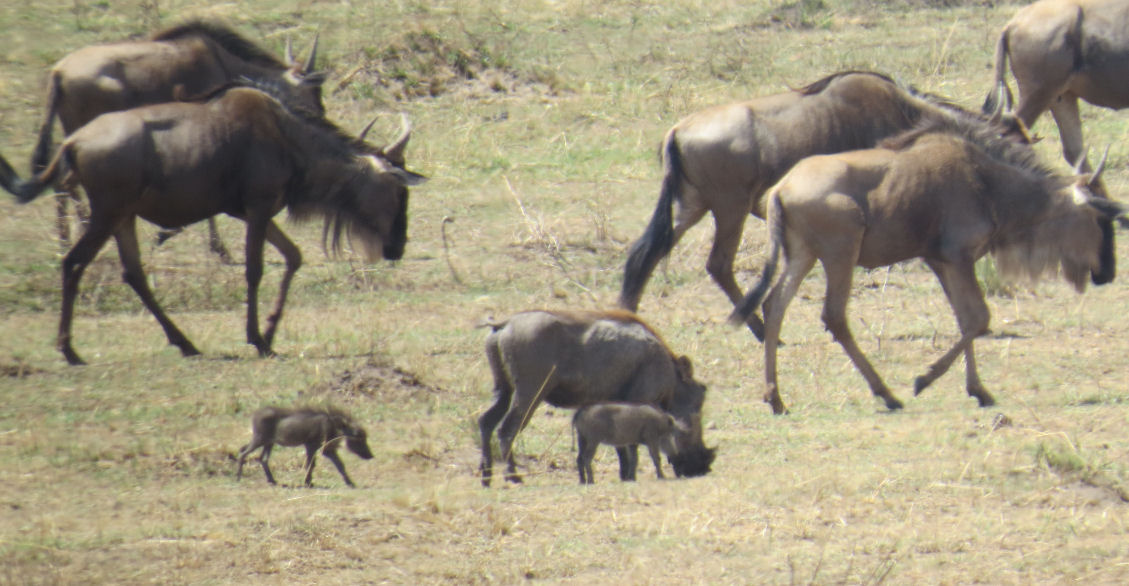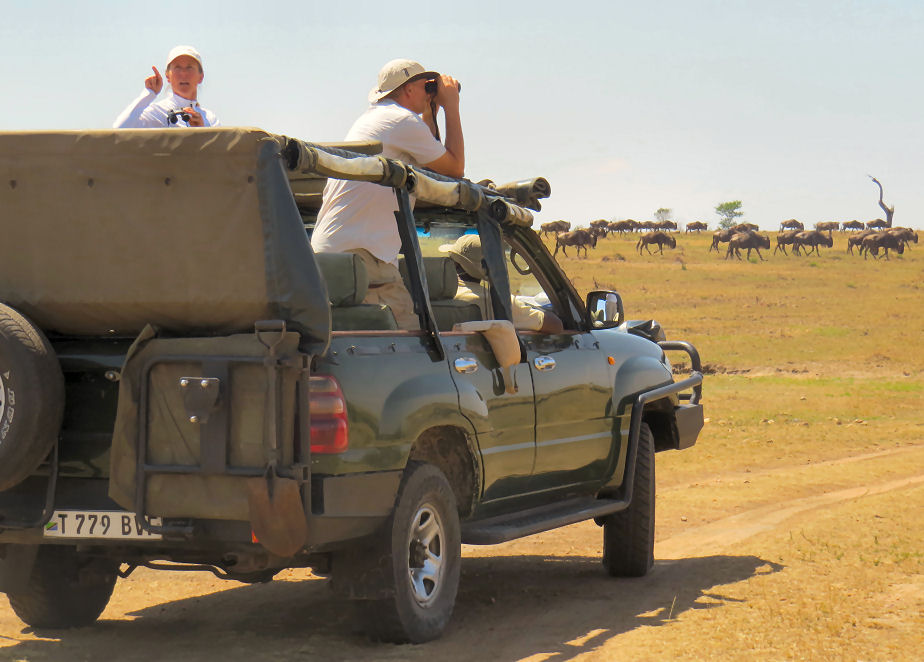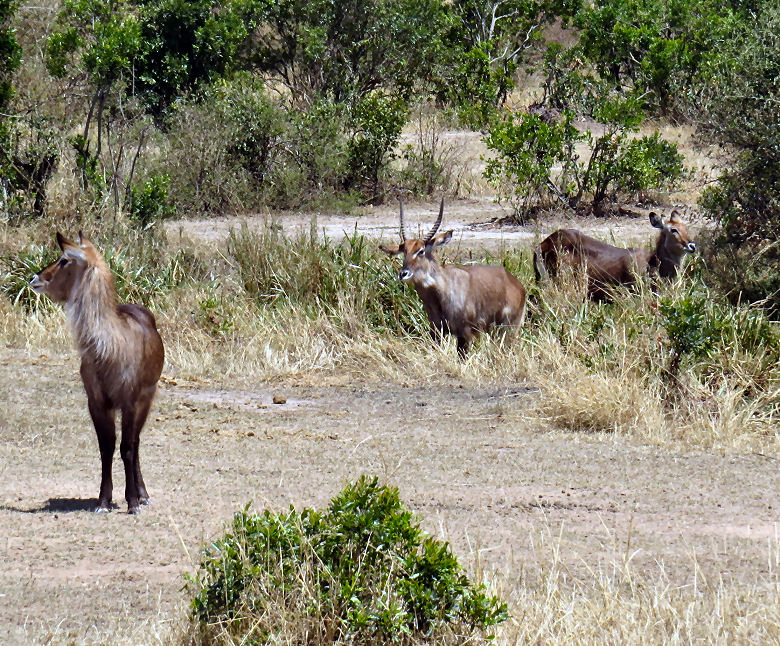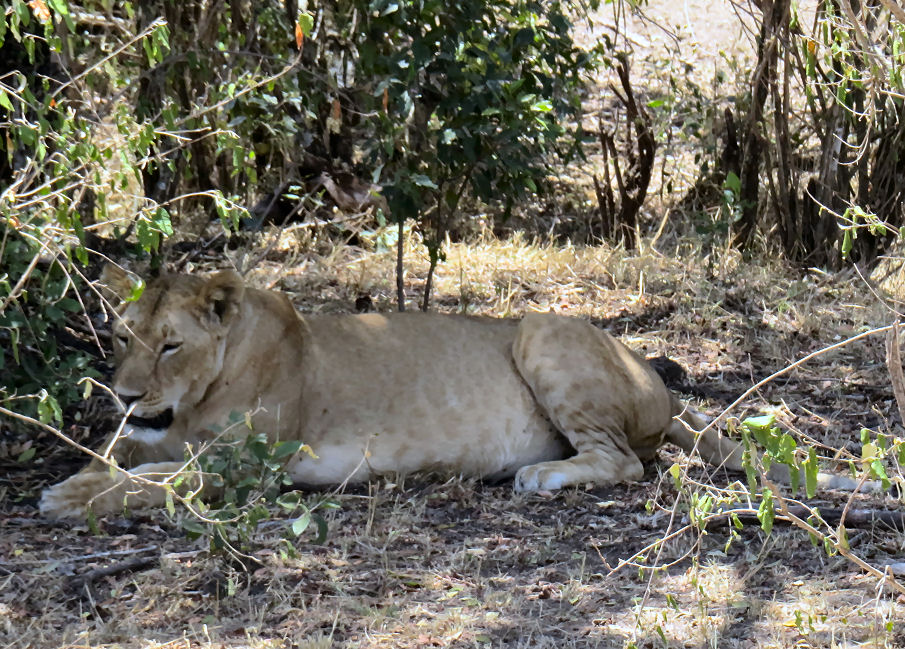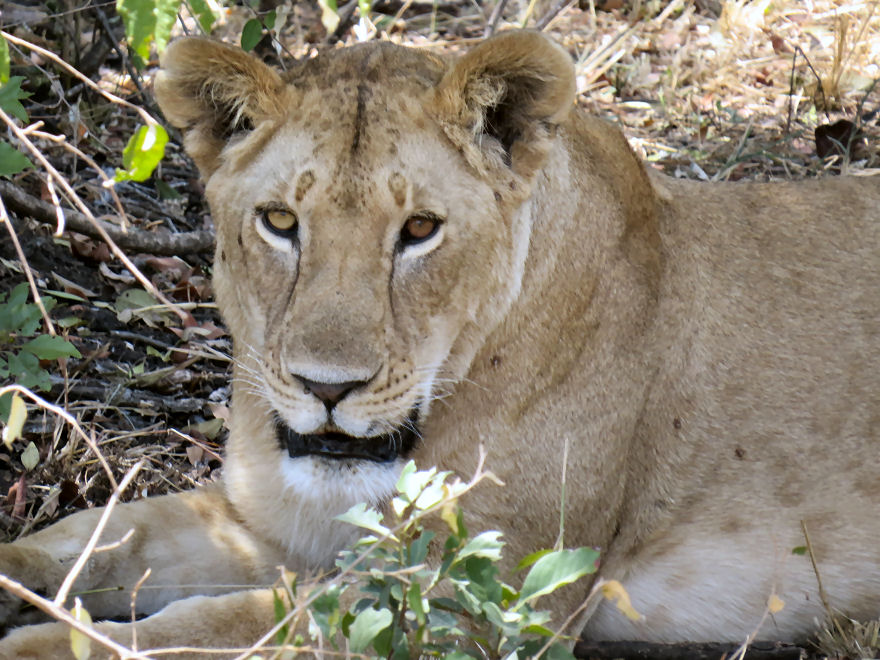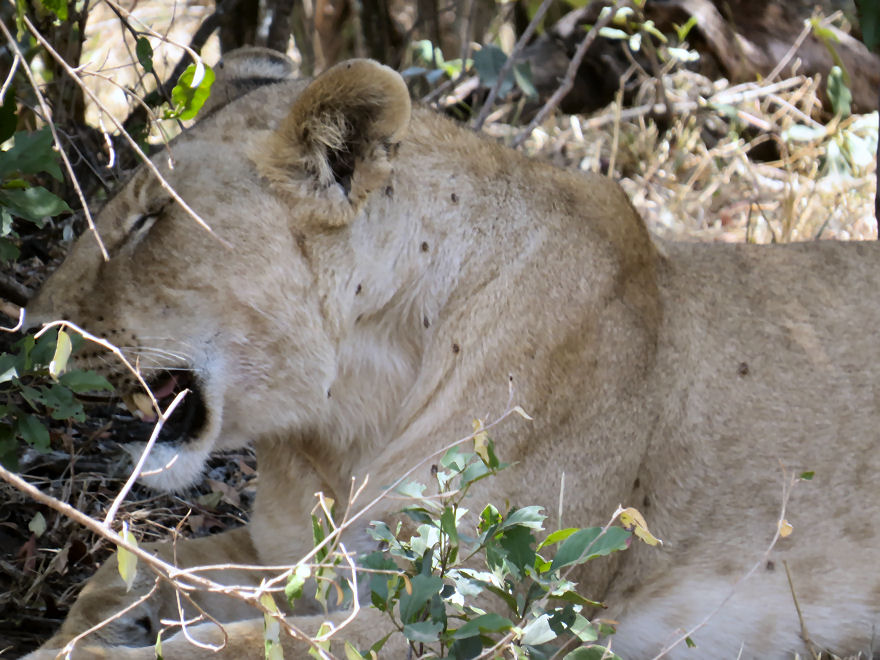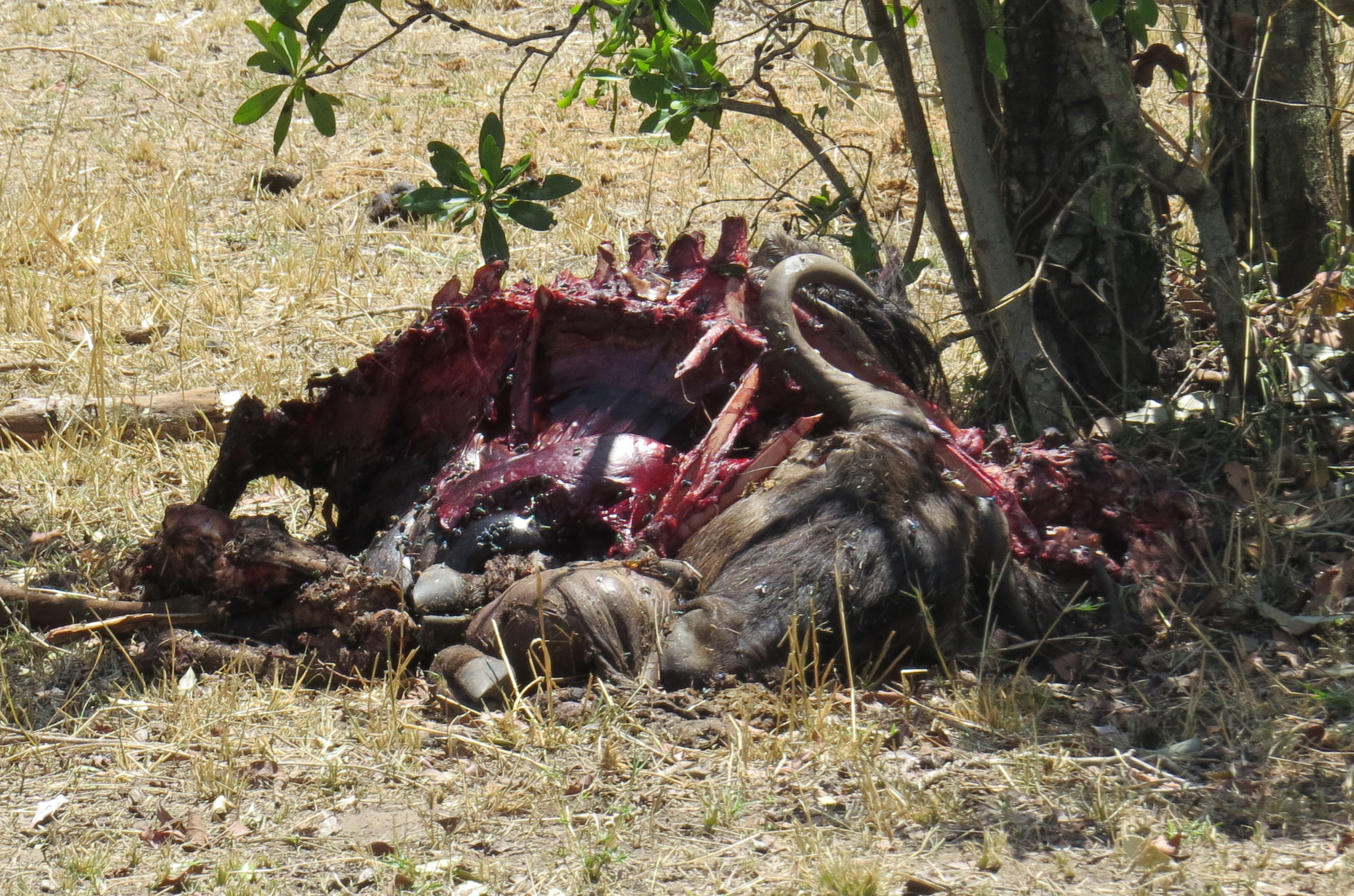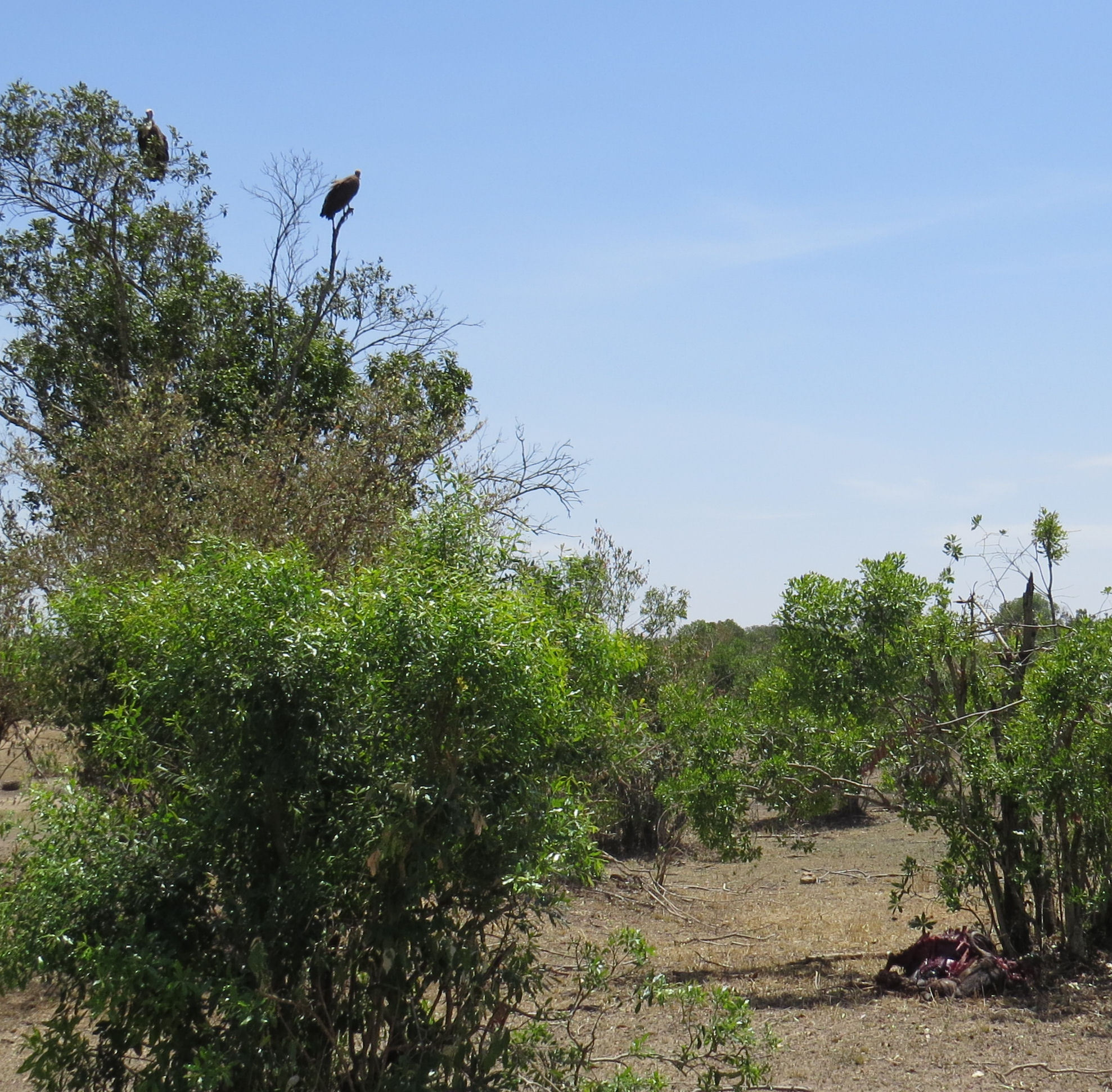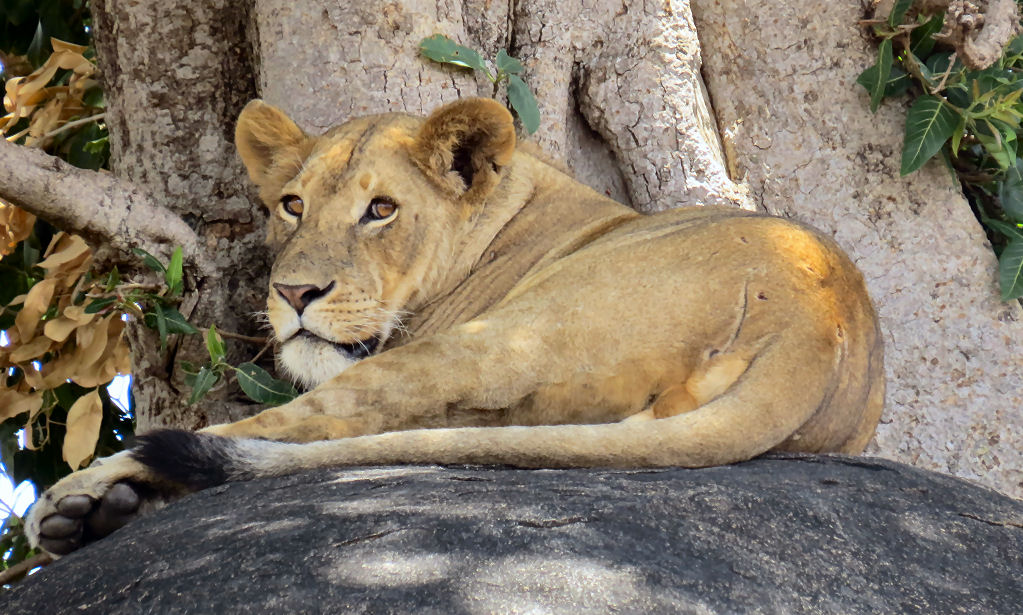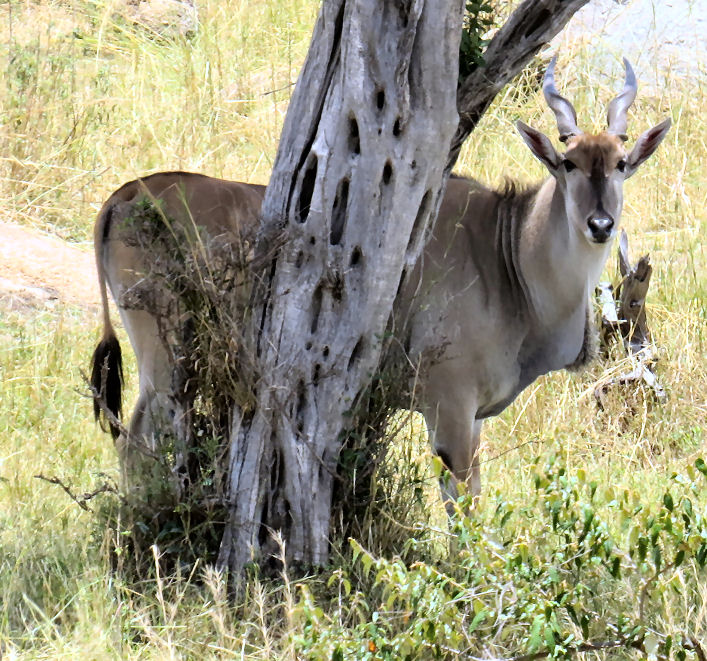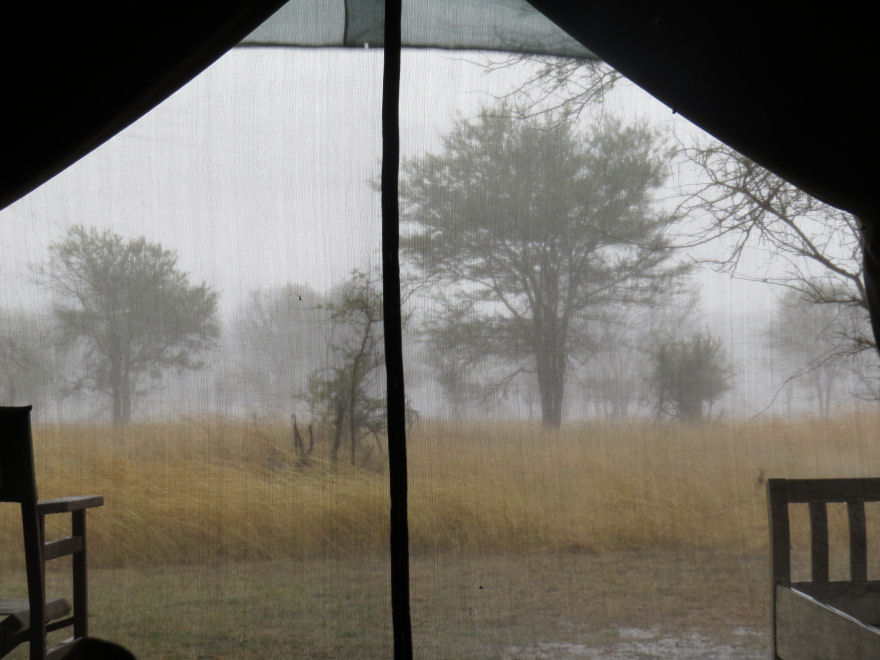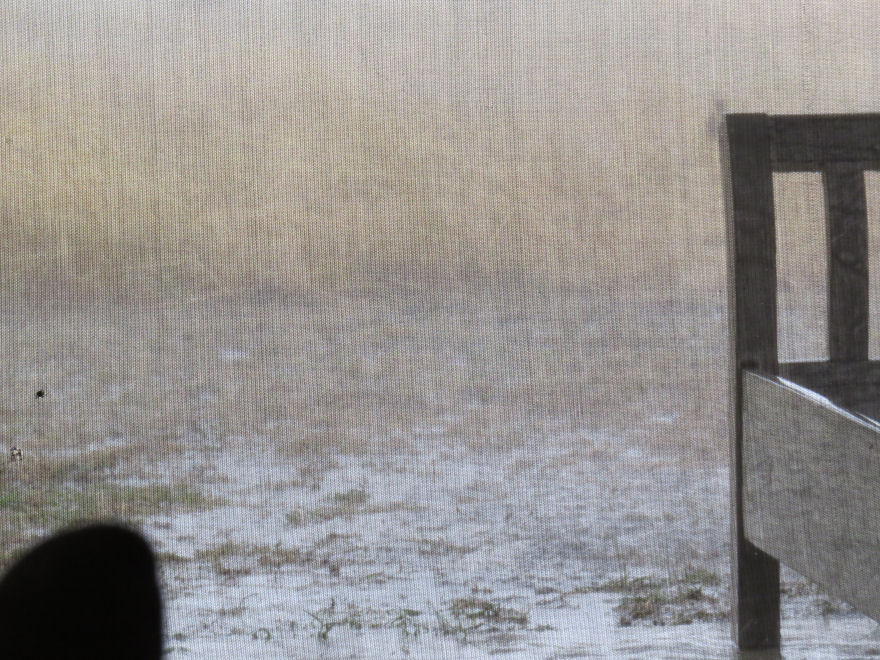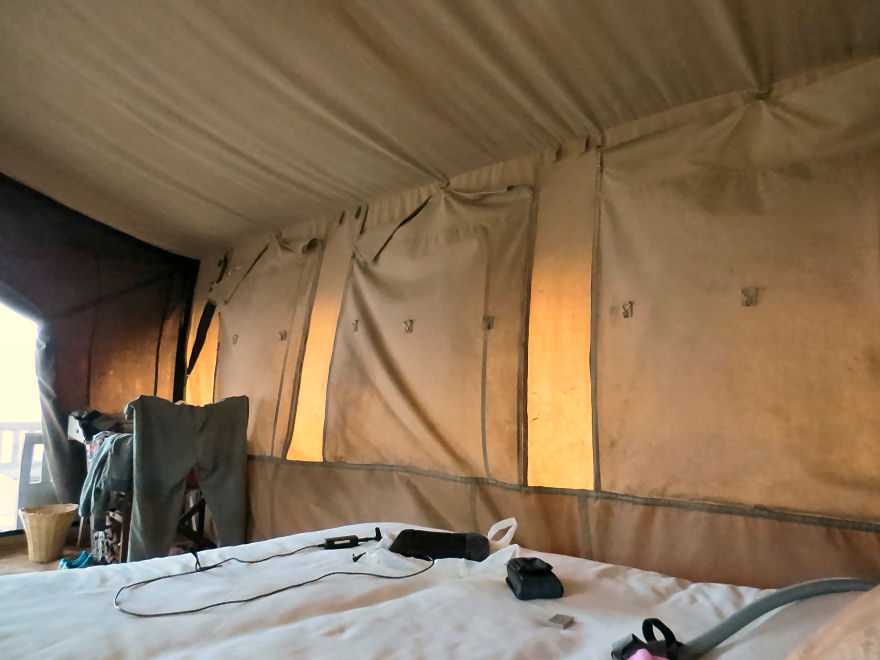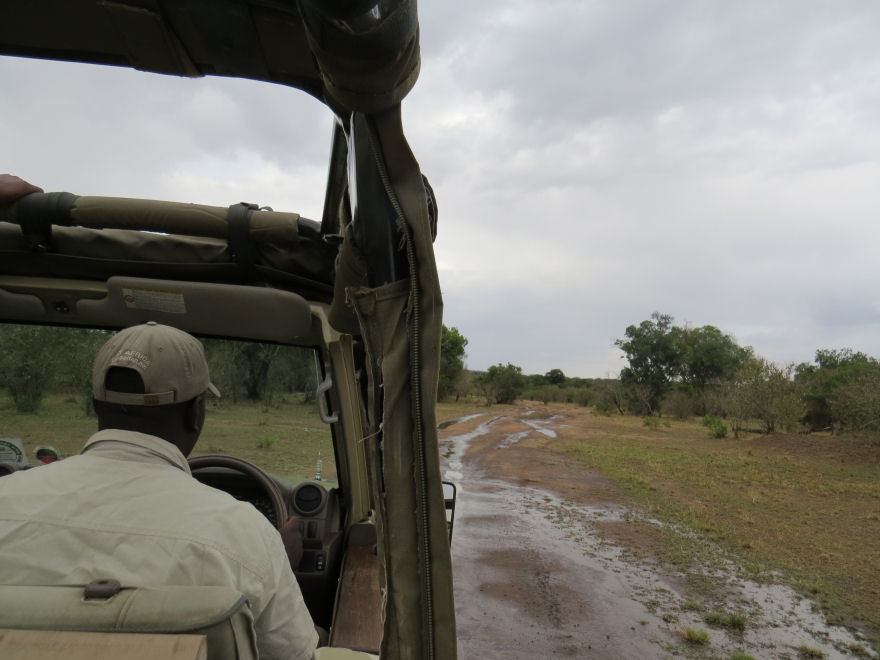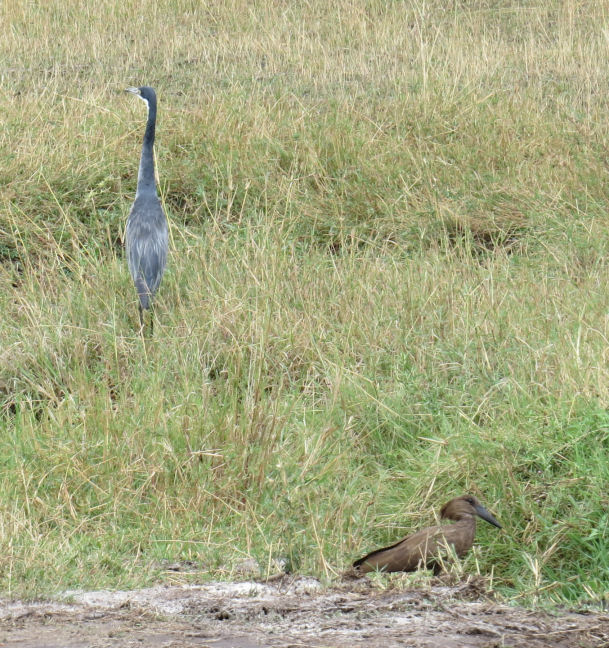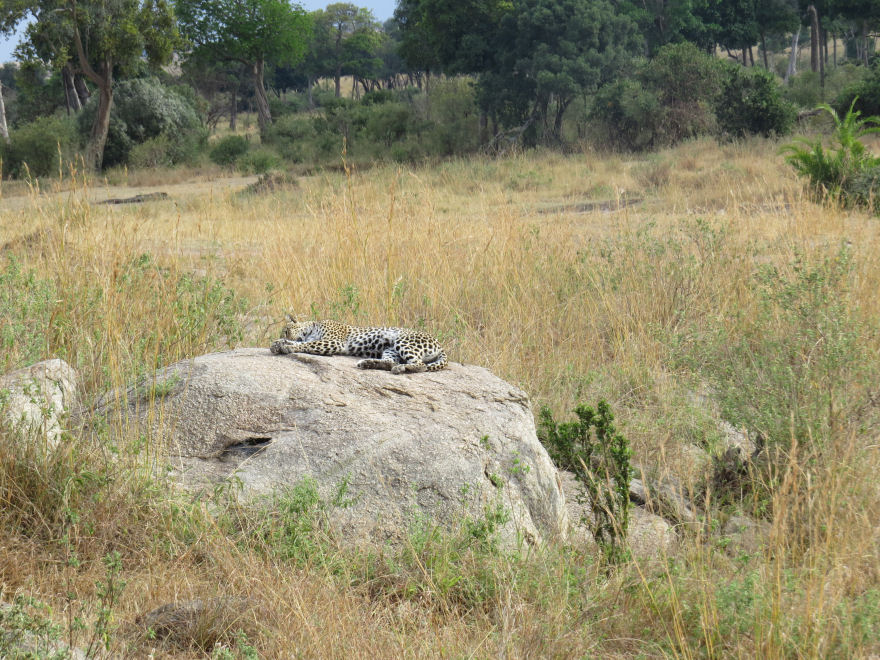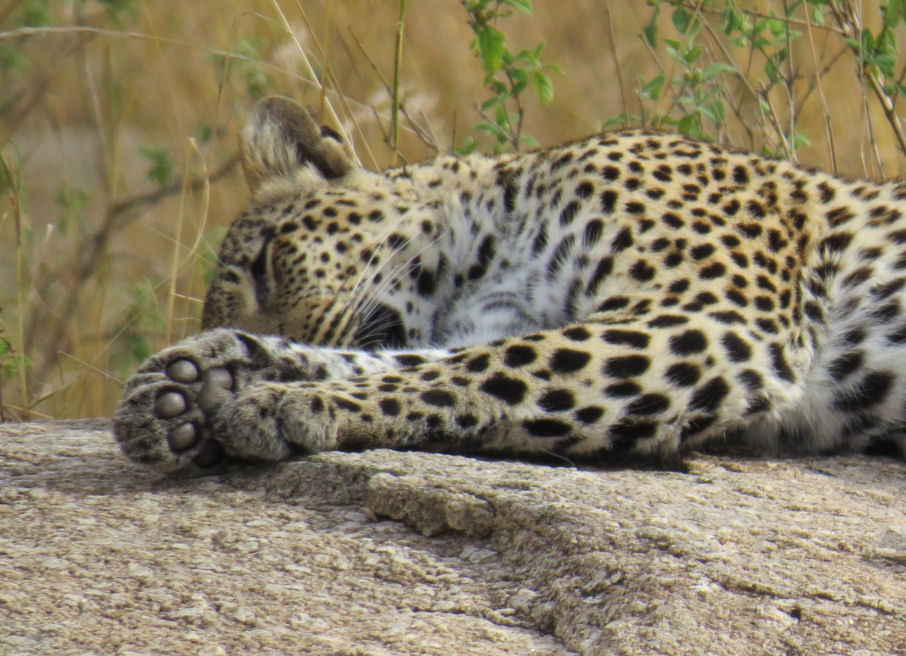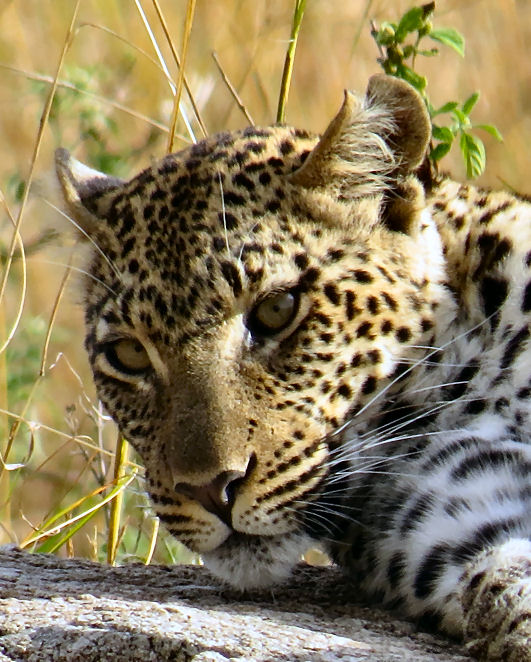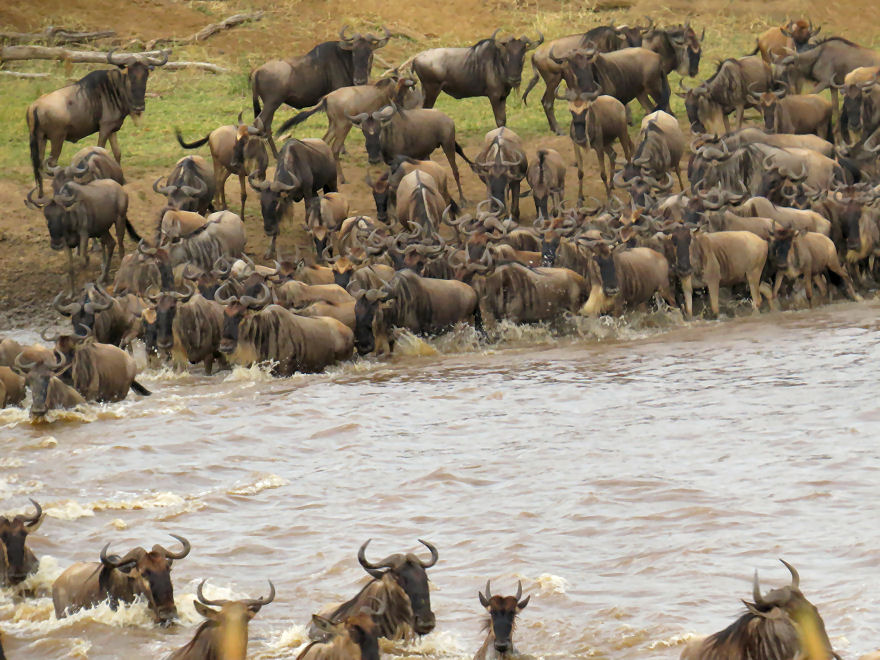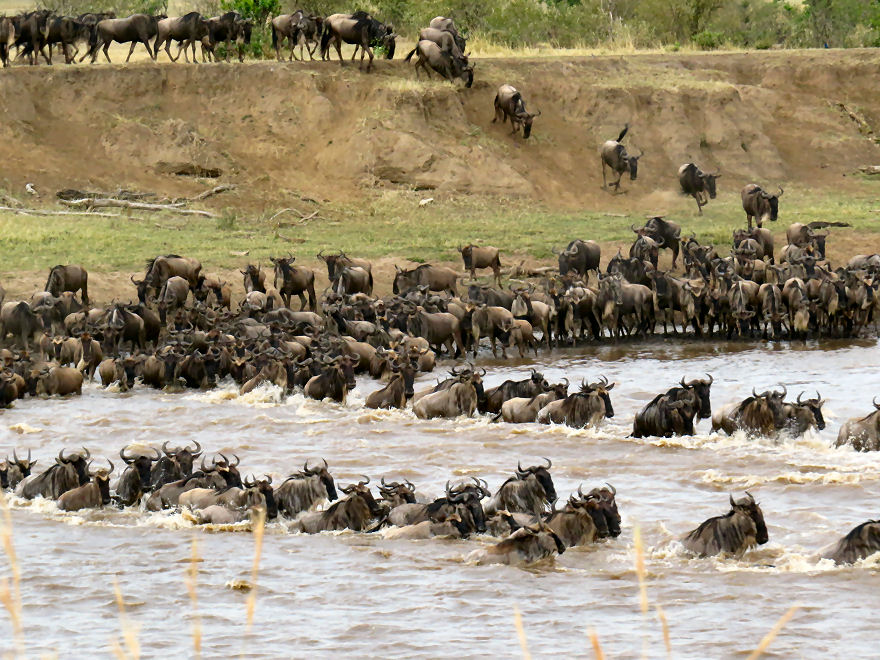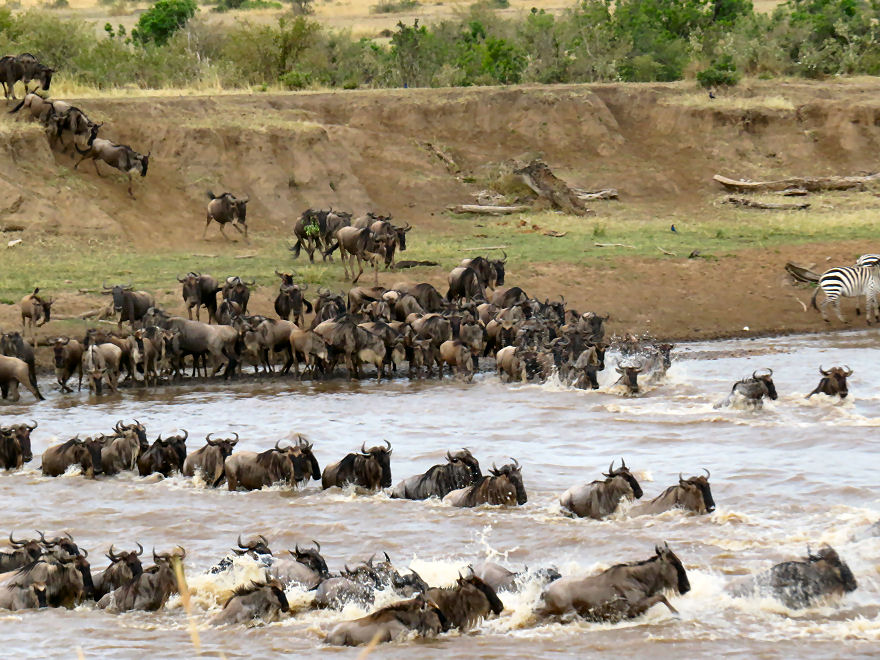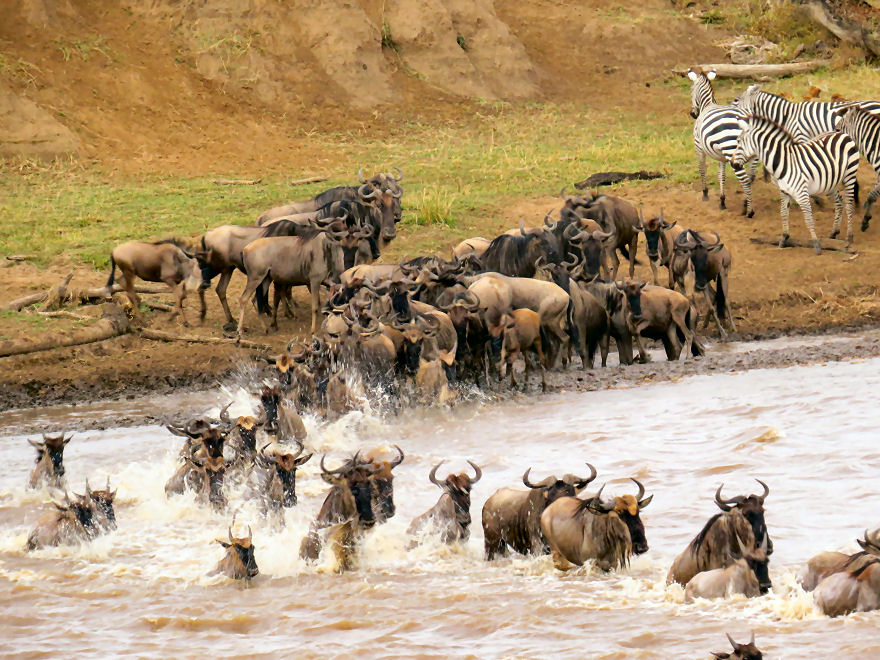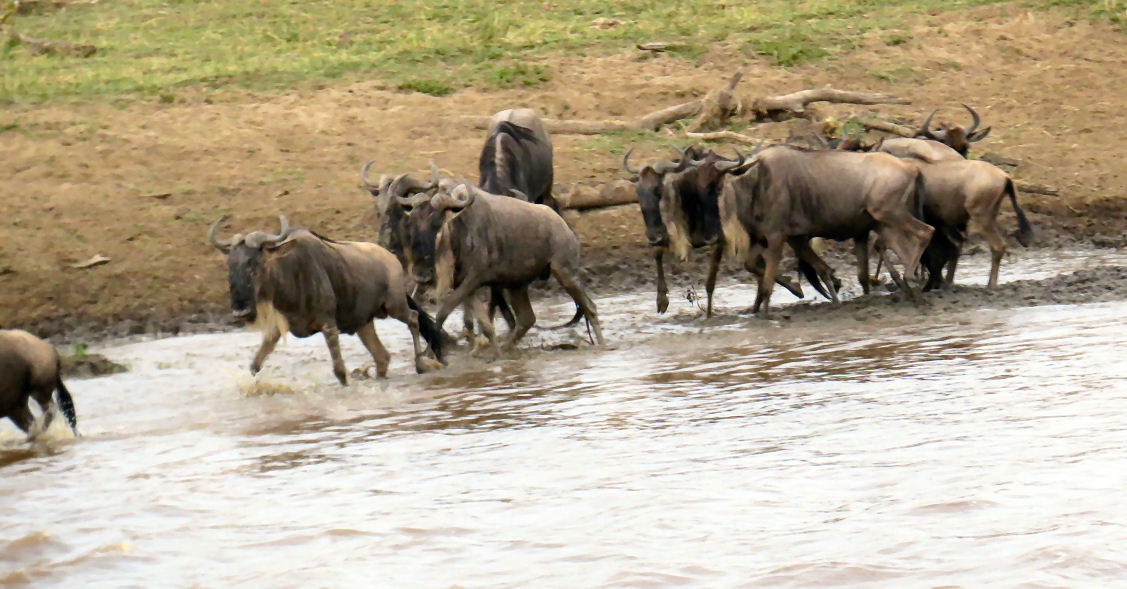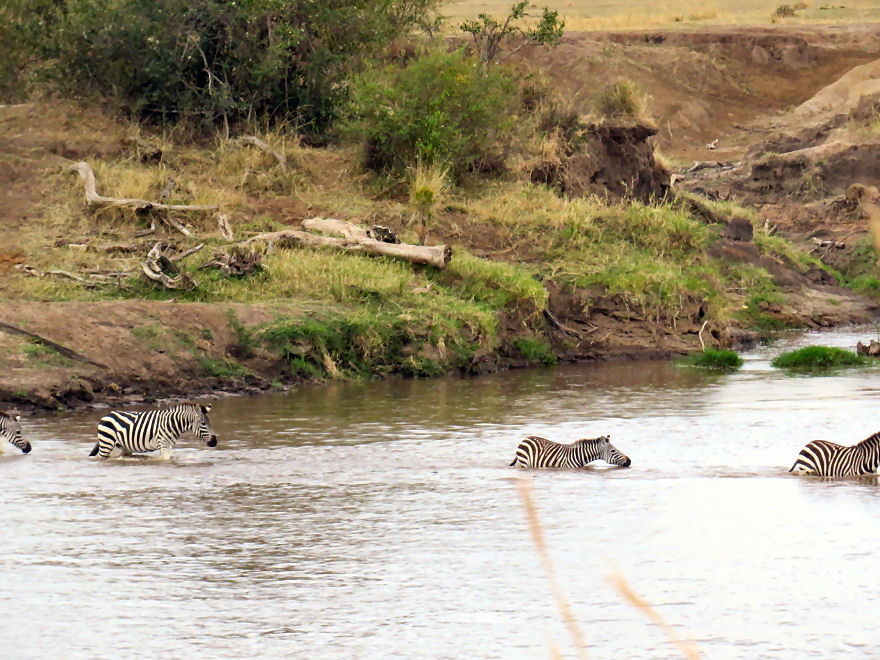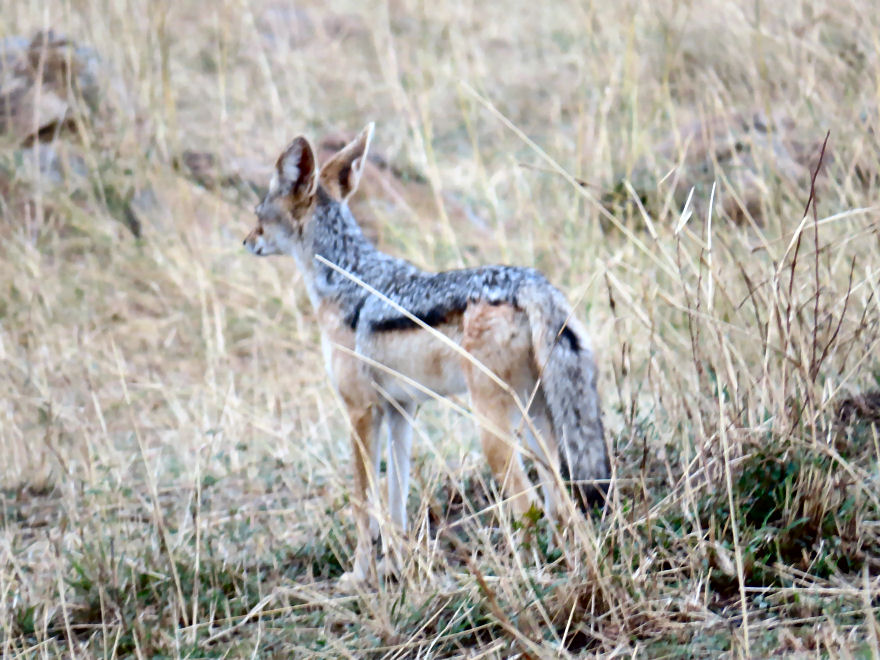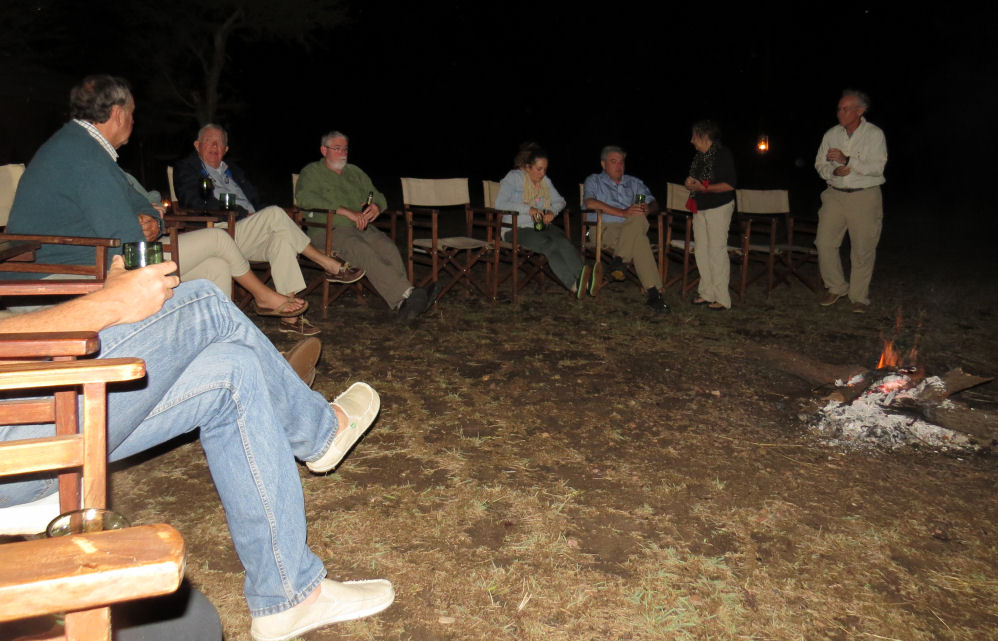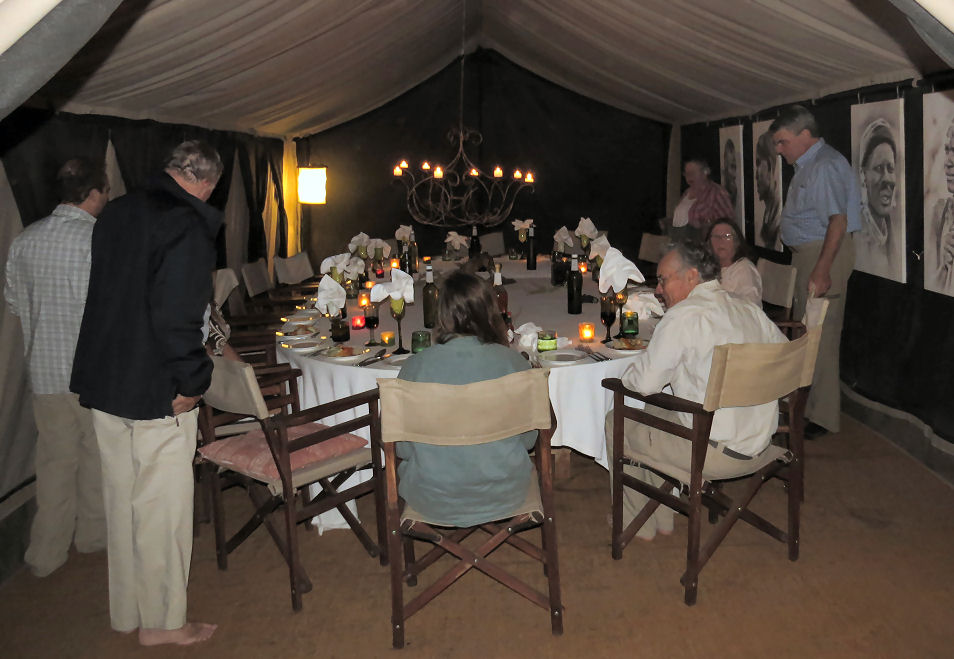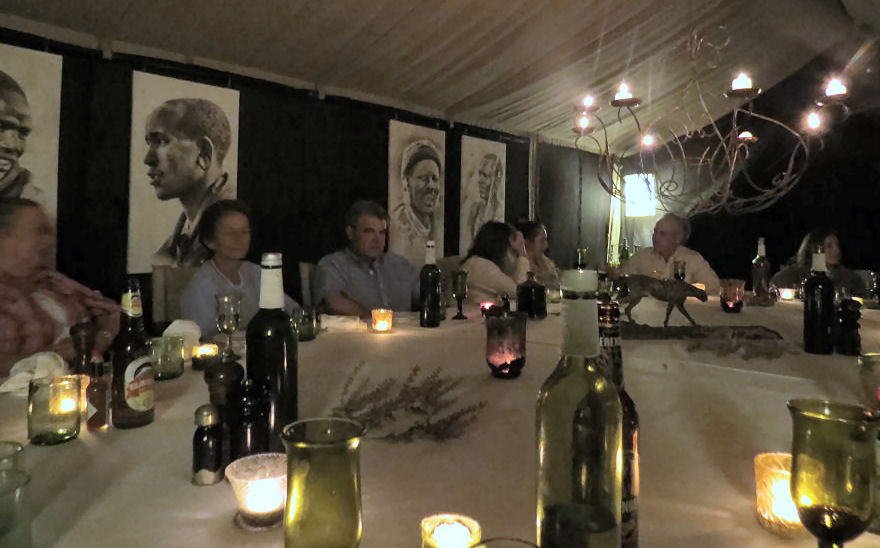On Sunday morning the staffer came by at 6 a.m. to wake us up and bring us our daily coffee and "biscuits."[1] I felt better. The coffee and the treat tasted better, and my digestive system was apparently back to normal. My attitude had markedly improved too.
I spent the early morning hours copying all of my photos from the memory card to the flash drive. However, I forgot to clear the camera's memory, which meant that the flash drive ended up with two copies of the Saturday photos.
At 6:29 I was the first tourist to arrive at the vehicles. Belinda was already there to see us off, of course. The rest of our group arrived within a few minutes. They seemed a little bleary eyed.
I had a difficult time imagining what the day would bring. We had already seen just about everything that we had hoped to see. I knew that the wilderness was always full of surprises, however, and I was sure that in my healthier state I would be much more alert and cheerful.
We saw a few wildebeests, of course, and I decided to try to take a photo of just one of them. The entire ecology of the Serengeti revolves around the peculiar habits of this strange animal. I envisioned a section of the journal in which I explained to the masses once and for all its many eccentricities. I wanted the image of one prototype for the introduction. If I ever figure the wildebeest out, I will add that section. One or two of the photos seemed usable.As usual we saw a few interesting birds. The first was a lappet-faced vulture. Baraka explained that these large scavengers often get first crack at a corpse because they have very strong beaks that can rip away the flesh. Also, none of the other scavengers want to mess with them.
We then spotted a stunningly beautify violet-breasted roller and a stunningly plain Rüppel's griffon vulture. I managed to get pretty good photos of all three of these birds. We also spotted a black-shouldered kite, but I failed to get a shot of it.
Then we came to Scavenger City. I would not have imagined that there were so many vultures and storks in all of the Serengeti as were congregated here in an area that was no larger than a football field.
The object of attention of all of these disgusting-looking birds was not yet in sight. We had to drive down to crossing #1, a few yards away. There we could see the carcasses of a large number of wildebeests, mostly in the river. This must have been the carnage that Chris described viewing on Friday morning. Two days later it did not appear that all of these scavenging birds had even made much of an impact. Apparently these birds were still powerfully attracted to this mass of rotting flesh even though they were all so gorged with wildebeest meat that they could not possibly fit any more in their bellies. So, they congregated and skirmished over nothing.
We would not be around to see how this eventually played out. Presumably all of those corpses would one by one disappear, but how this would happen was not a bit apparent, at least not to any of us.
Baraka drove us down to crossing #4, where we observed wildebeests calling loudly to one another from both sides of the bank. Eventually, we witnessed a group from the southern shore make a very orderly crossing to the north, that is, away from us. This was one of the few times that we got to see what the wet animals did after they completed the crossing. In this case the total number of animals was not that great, perhaps one hundred, and so there was little danger of the kind of catastrophic bottleneck that had resulted in the carnage at crossing #1.
Several hundred yards on the other side of the river we witnessed a very unusual sight — three jackals were chasing an impala. Wait a minute; those are African wild dogs, not jackals. Baraka, who had his binoculars trained on them throughout, identified them, and the sighting was confirmed by other guides. We later learned that wild dogs had not been spotted in the northern Serengeti since 1989! We were actually a witness to a historic occasion.
We also saw a big male warthog. I was able to capture an image of neither the wild dogs nor the warthog. I am not skillful or experienced enough to shoot animals on the move at that distance.
Breakfast was provided at a different location. I am not sure where we were, but there were two streams that formed a T. So, there were three banks; two were L-shaped, and one went along the longer stream. We were on that shore, not too far from the water. The players in this scene were fourteen giraffes and one fat female crocodile, who had exhibited absolutely no interest in the antics of her leggy neighbors.
I am not sure what the giraffes were trying to accomplish, but they entertained us for quite a few minutes by crossing back and forth. Eventually almost all of them ended up on the left side of the far shore.
I wonder if giraffes can swim. Somehow I doubt that most have even tried. Unless they wandered into one of the lakes, the giraffes of Tanzania would never need to find out. They could easily walk across any of the rivers or streams that we saw, at least in the dry season.
We then were treated to the peculiar scene of one hippo chasing another. After that we saw a very large number of hippos in and near the water.
Baraka found another leopard for us. This one was even more difficult to see than the others. Almost as soon as we arrived, it abandoned its perch on the rock and bounded through the brush. Some of the others got a photo or a movie of this episode, but I missed it entirely.
I was more successful in our next encounter. I snapped a very nice shot of a warthog and some elephant dung. Both of these are much more common than leopards in the Serengeti, but I feel strongly that my artistic choice of juxtaposing the two of them in one image made a strong dramatic statement about the day, the Serengeti, Africa, and life itself.
We came across a male buffalo that appeared to be even more ill-tempered than any of the others that we had seen. Someone in camp had said that they had seen a herd of four hundred buffalo on Saturday. Baraka scoffed at this claim. He said that he might believe in an aggregation of one hundred buffaloes, but four hundred was inconceivable. I think that the buffalo herd that we saw in Ngorongoro might have had as many as one hundred. In the Serengeti the groups that we saw in the Serengeti numbered no more than five or so individuals.
I decided to try for a photo of one zebra, too. The zebra plays straight man in many of the comical scenes concocted by the wildebeests.
Speaking of wildebeests, we saw a pretty large herd of them near a small stream. A few of them wandered down to the water to get a drink. Herd mentality prevailed. Eventually the entire group not only drank from the stream, but crossed over to the other side as well. We watched them for a considerable period of time.
I took lots of photos. None of them were as dramatic as the ones of them crossing the Mara. I also got a shot of a warthog and her piglets as they were were grazing and rooting near the herd.
For a few minutes we watched three extremely photogenic waterbucks.
Waili and Baraka then found a pair of lions, and we watched them as usual for a few minutes. One thing that was notable about them was that they were covered with flies.
When I wrote "as usual" I meant that we stood up, spoke softly, and took lots of photos and movies. Something perturbed the male lion, and Baraka, for the only time in four days, spoke sharply to us, "Sit down!" We did, and Baraka left the lions in peace. I am not sure what in the lion's behavior cued Baraka, but one does not want to get on the wrong side of a lion, even in a Land Cruiser.
This pair had evidently completed a successful hunt the previous evening or early that morning. Nearby we came across some of the remains and, of course, vultures looking for a meal.
Later we saw a topi, but I did not manage to shoot a photo of it. Sue then asked Baraka to stop for a minute so that she could retrieve a ginger ale from the cooler. She felt that she was beginning to get car sick. Evidently the ginger ale did the trick.
For as long as we could tolerate it, we observed another lion lying nearly motionless on a rock in the shade. Shortly thereafter we saw a large blue truck. Baraka explained that these trucks delivered supplies to the various camps. It seemed extremely strange to see it in the middle of the savanna.
We then spotted a ground hornbill that had never won a beauty contest. In contrast, two fetching but demure female elands definitely seemed ready for the runway. I got a photo of one of them.
As we passed another vehicle, Baraka stopped and conversed with the driver. Throughout our game drives this was a common occurrence. The guides knew one another well, and they often exchanged information and pleasantries. In this case, however, no passengers were in the car. So, we deduced that it was not another guide. It was, in fact, the head ranger.
Lunch was a special occasion. Betty stayed in her tent. We later learned that she had been suffering from an upset stomach. In her place was Alex Walker, who was rather excited about the sighting of the wild dogs. He was the one who told us how rare they were.
Alex also disclosed the results of the U.S. Open tennis matches. This was the first and, as it turned out, the only news that we received in the fortnight that we spent in Africa.
I sat next to Gerard again. I asked him about our flight to Katavi. The itinerary said that it would be "departing at approx.. 0800 to Katavi via Tabora arriving at 1200." Since the itinerary had overestimated the time of our last flight by a factor of two, I wondered if it really took four hours to get to Katavi. He told me that the flight to Tabora, which is a city with a functioning airport, required two hours, and one hour would be needed to fly from Tabora to Katavi, which has an airstrip like the one in Kogatende. A large portion of the other hour would be spent on the ground in Tabora refueling.
He also said that there was a lot of game in Katavi, but very few people (he actually said "nobody") went there. He predicted that we might have the whole park[2] almost to ourselves.
As we were leaving the mess tent, Gerard predicted that there was going to be a cloudburst. He was definitely prescient.
Sue spent most of the break time in the Nest, a.k.a. the bar. I am not sure what she was doing. I was in our tent alternately reading my book and taking cat naps, the same thing that I did during all of the previous midday breaks.
At about 1:45 it started to rain, and it rained very hard. When it started I was asleep, and I have slept through many terrible storms. This one awakened me. The wind was blowing fiercely. I had to close all the flaps on one side of the tent to prevent the inside of the tent from getting wet. I also brought in the cushions from the couch that was outside the front of the tent, but they were already soaked. After about forty-five minutes the foul weather terminated abruptly, and the skies began to clear in plenty of time for our afternoon game drive.
Our tent survived the onslaught intact. Sue said that the Nest was not threatened either. Jeff and Betty, however, reported that the canvas covering the front entrance of their tent had blown off. These tents were not Walmart specials; I could hardly fathom how anything short of a hurricane could have damaged one of them.
I wish that I could have taken some photos of Betty and Jeffrey's tent, but the damage had apparently been repaired by the time that I learned about it.
I asked Baraka if we would have attempted the game drive in that storm. He answered in the negative. Fortunately, there was enough time for everything to dry off a little, and all five of us went on our last Serengeti game drive at 4:00, the usual time.[3]
The first bird that we spotted, or at least the first to make it into my notebook, was a black-headed heron. A hamerkop was also nearby.
In some places in which the roads had previously been dry as a year-old wildebeest skull, pools had formed. They were no threat to the Land Cruiser.
We saw a northern white-crowned shrike, an elephant, and a white-browed coucal. The first and last are birds. I did not manage a photo of any of them. I do not recall whether I was lazy or inept.
We also spotted another leopard. They were beginning to seem commonplace to us. I mean, we had almost six days of game drives under our belts. This was the group that saw the wild dogs! Maybe an albino leopard would be enough to capture our attention, but please do not bother us with still another recumbent big cat.We saw some dark clouds, but we encountered no more rain. In fact we soon came to an area that the storm had missed entirely. That seemed totally incredible to me. This area could not be more than ten miles from the camp, and we had experienced a deluge there that lasted for forty-five minutes.
We then watched a large number of wildebeests gathered on the far shore of the river. They were up on the plain, perhaps twenty or twenty-five feet above the river. Two paths shaped like \_/ led down to the grass-covered shore, where there was enough space to accommodate fifteen or so. Suddenly wildebeests began descending the path on the left in single file. They immediately went back up on the right. This lasted for about five minutes. A little later some of them descended on the right path and climbed back up the left path. This also lasted for a few minutes. Then the left path became the entryway again, but this time things were a little more chaotic.
I thought that at that point I understood enough of the wildebeest mindset to predict that a crossing was about to occur from this little beach. I was, of course, wrong. A crossing occurred almost exactly when I expected, but it started on the herd's left flank at a point one hundred or more yards up the river. All of the recently descended wildebeests across the river from us climbed back up, and the entire herd moved down to the newly selected crossing point in an unexpectedly orderly manner.
This crossing was a large one, and I took over sixty photos of it.
The last sighting of the day was a jackal, and I actually managed to get a photo that showed off its coat of many colors. As we drove back to camp for the last time, I engaged Baraka in a discussion about the future of the Serengeti. I told him that I planned this trip so that I could witness the migration first-hand while it was still possible to do so. I just could not believe that something that required such an enormous allocation of land could be allowed to continue in the twenty-first century, where everyone thinks in terms of the bottom line.
Baraka disagreed vehemently. He said tht his father worked in the park for thirty years, and it was no different when he quit than when he started. He insisted that the people of Tanzania understand how important the wildebeest migration was. He expressed certainty that in twenty years it will be just as it is now. I hope that he is proven right, but I remain a cynic.
That evening I took photos of both the campfire and the supper. I had to use the flash. At the campfire I actually enjoyed a beer, and I sat next to Chris. I told her about my idea of a genius wildebeest that emerged as a leader of the entire migration. Together we fleshed out how this might work in a story about the smartest gnu ever. She (Baraka had informed us that the first wildebeest in each crossing is always a female) would somehow convince the other wildebeests that crossing at only the ten traditional sights was ridiculous in light of the fact that the two-legged creatures had built a concrete bridge. As the herd congregated on the bank behind her, she would demonstrate for them how safe and easy it was to cross the river on the bridge. She would even do a little dance in the middle.
The wildebeests would celebrate Wilhelmina[4] as the most brilliant wildebeest of all time and charge down to effect the crossing. Soon they were actually galloping across the bridge. Unfortunately, they could not gallop up the other bank, a bottleneck developed, and wildebeests were inevitably pushed off of the banks and the sides of the bridge. Rather than walk the few feet to the shore the beasts tried desperately but unsuccessfully to climb up onto the bridge again. Chaos reigned over the most catastrophic crossing of all time.
Wilhelmina was then shunned by the herd. The other wildebeests went back to using their ten crossings. They soon bred their way out of this disaster, just as they have always done.
At first Wilhelmina had a strong impulse to trail after the herd. She, however, alone among the wildebeests had the intellectual capacity to fight the desire. She used her keen sense of smell to find others of her kind. Eventually she settled in Ngorongoro Crater, where the residents had no memory of the Mara River or its crossing points. Years later she was taken down by a lion, but this is considered a happy end to a wildebeest's life. At least she had no botfly larvae in her nasal passages.
[1] Americans call them cookies.
[2] Katavi is the third largest National Park in Tanzania.
[3] This kept intact my streak of never missing a scheduled activity on any trip because of weather. There is one asterisk on the list of activities. The canoe trip on the Dordogne scheduled for May 8, 2009, was replaced by a boat ride. This was probably weather-related, but the direct cause was that water had been released from a dam that was upstream.
[4] I came up with the name later.
